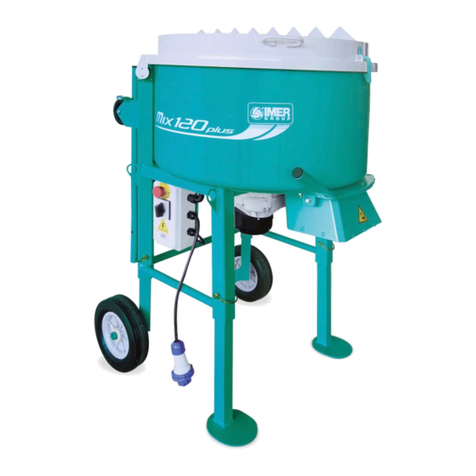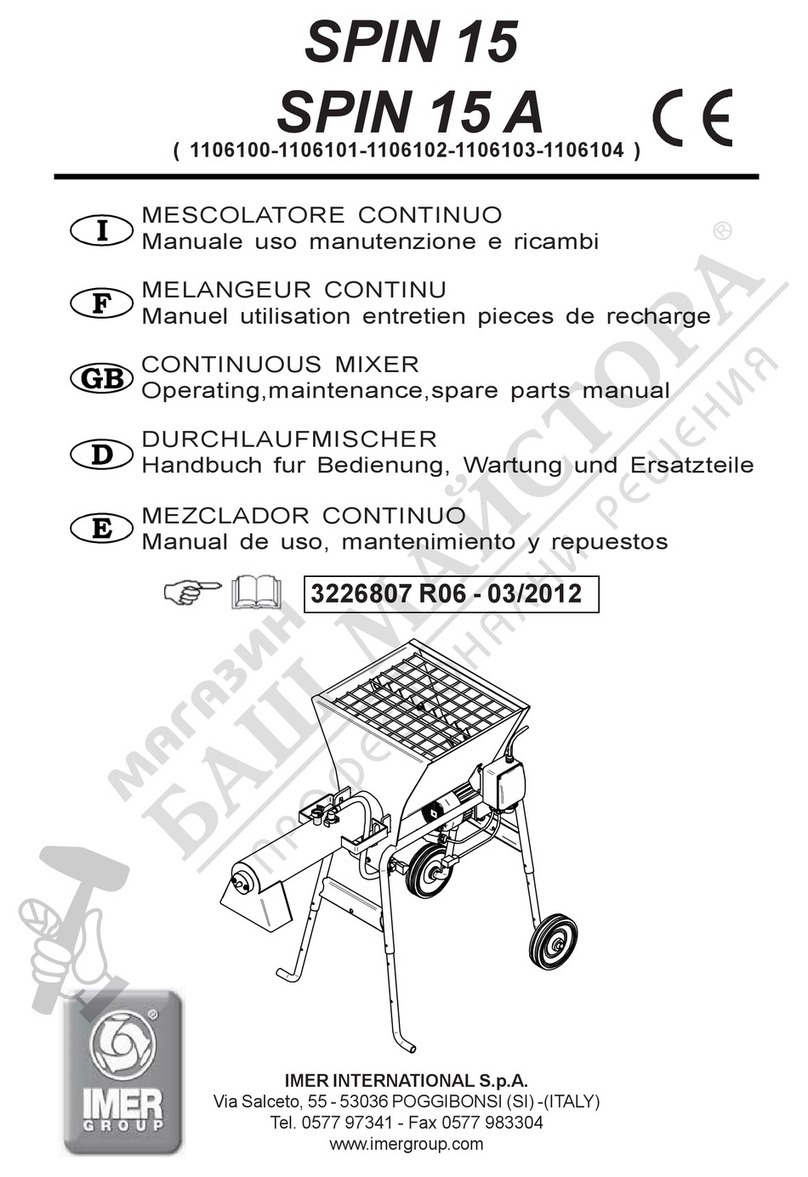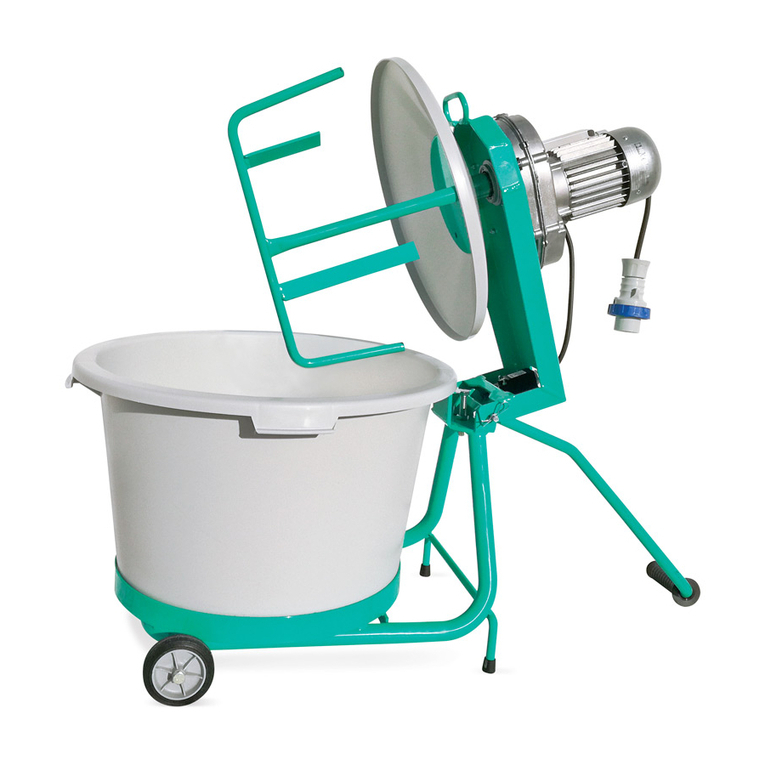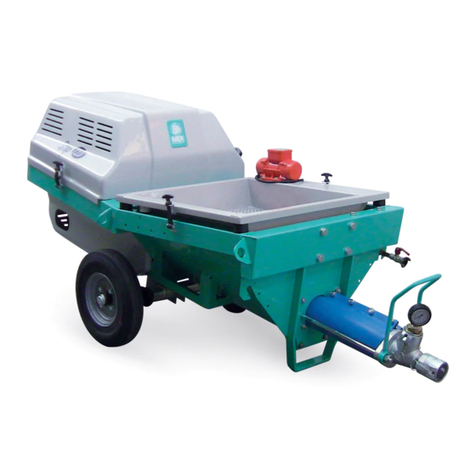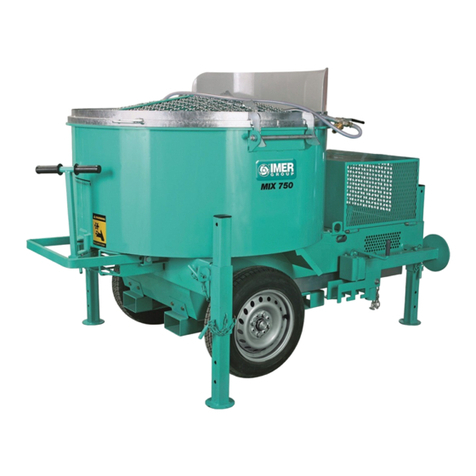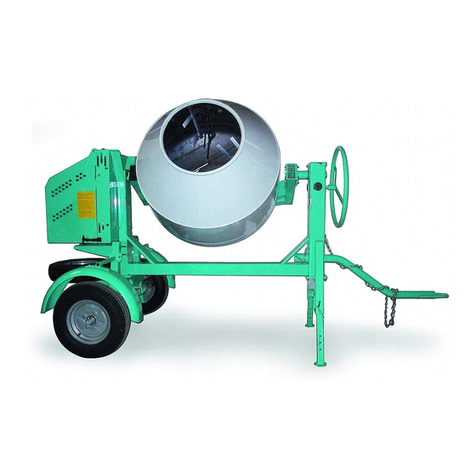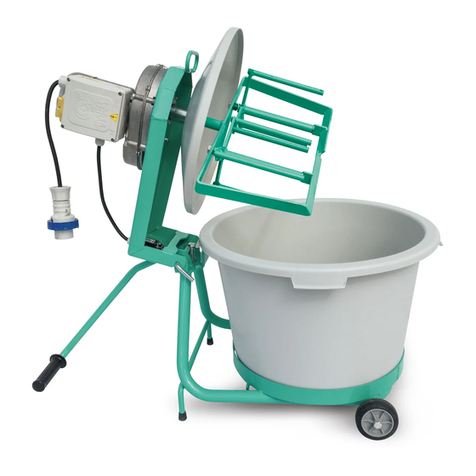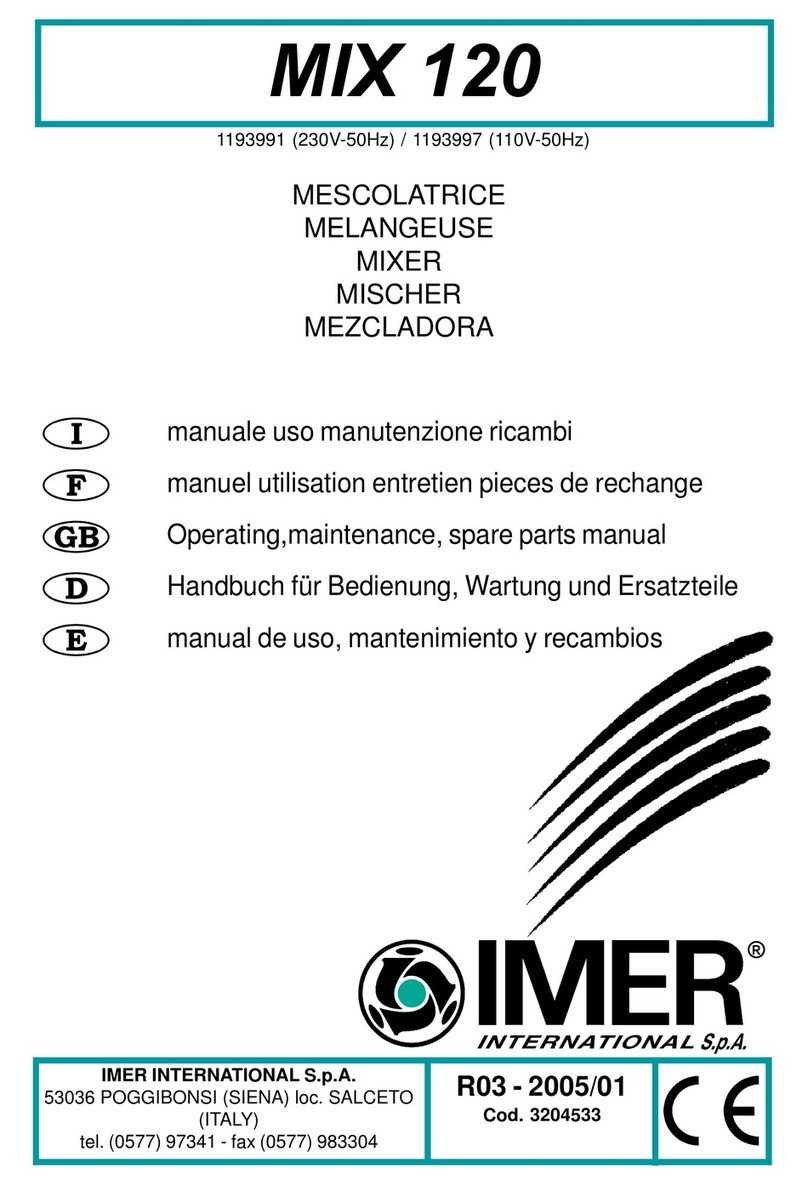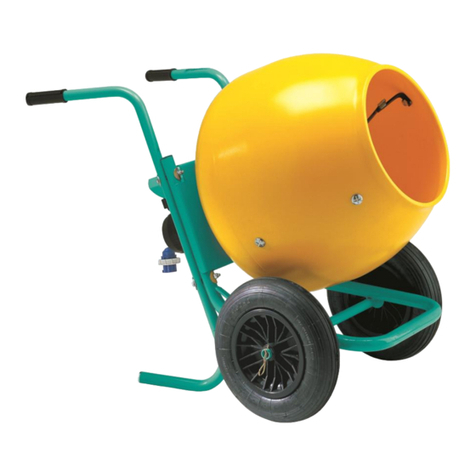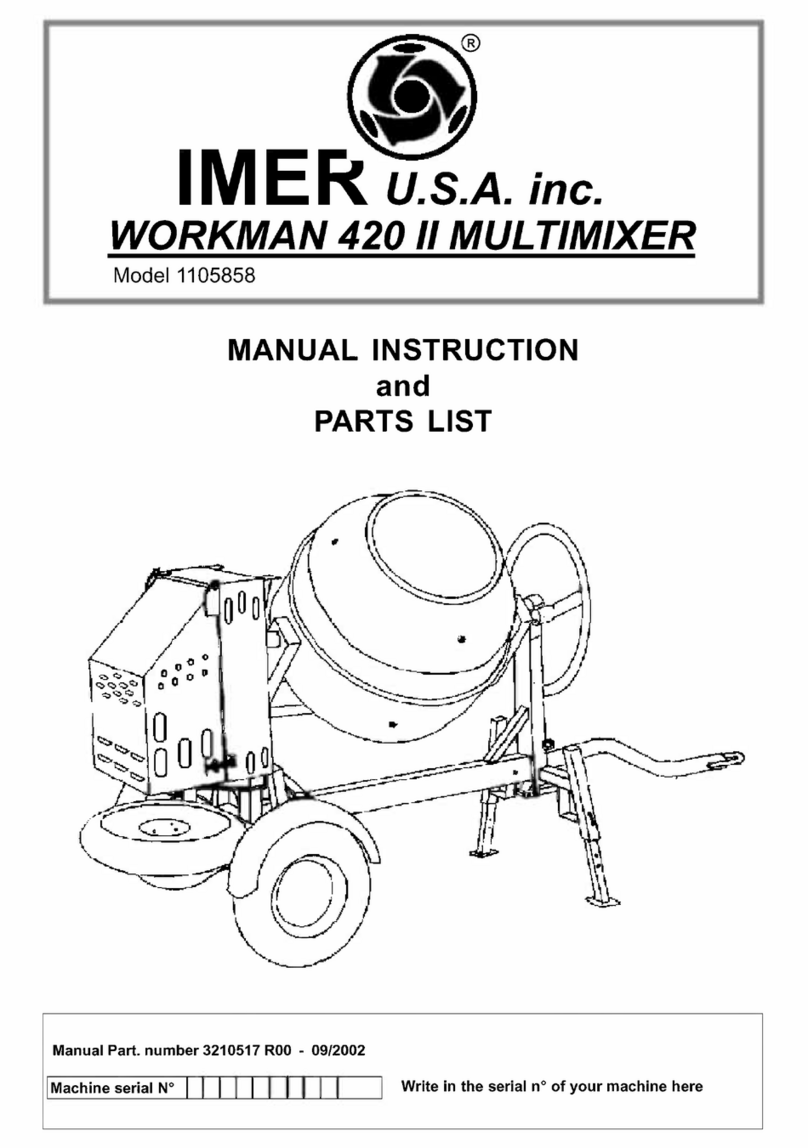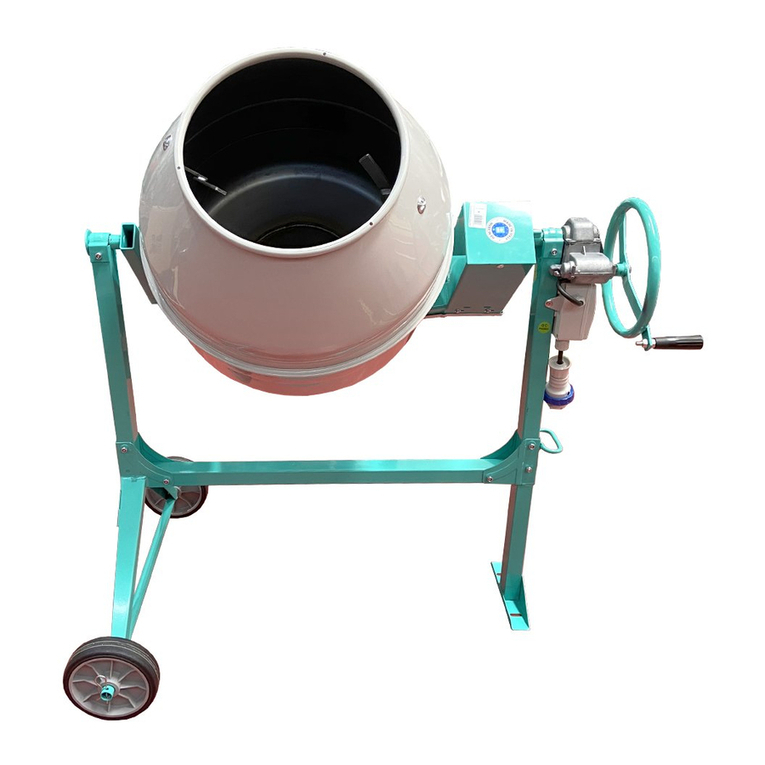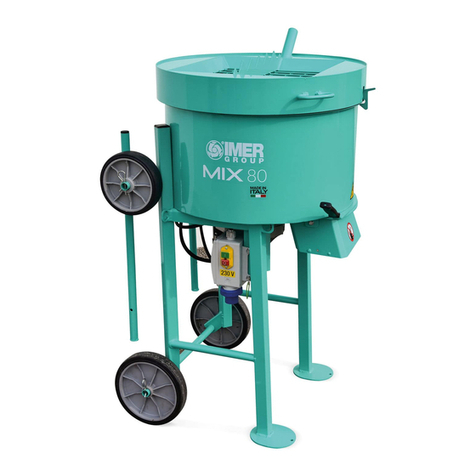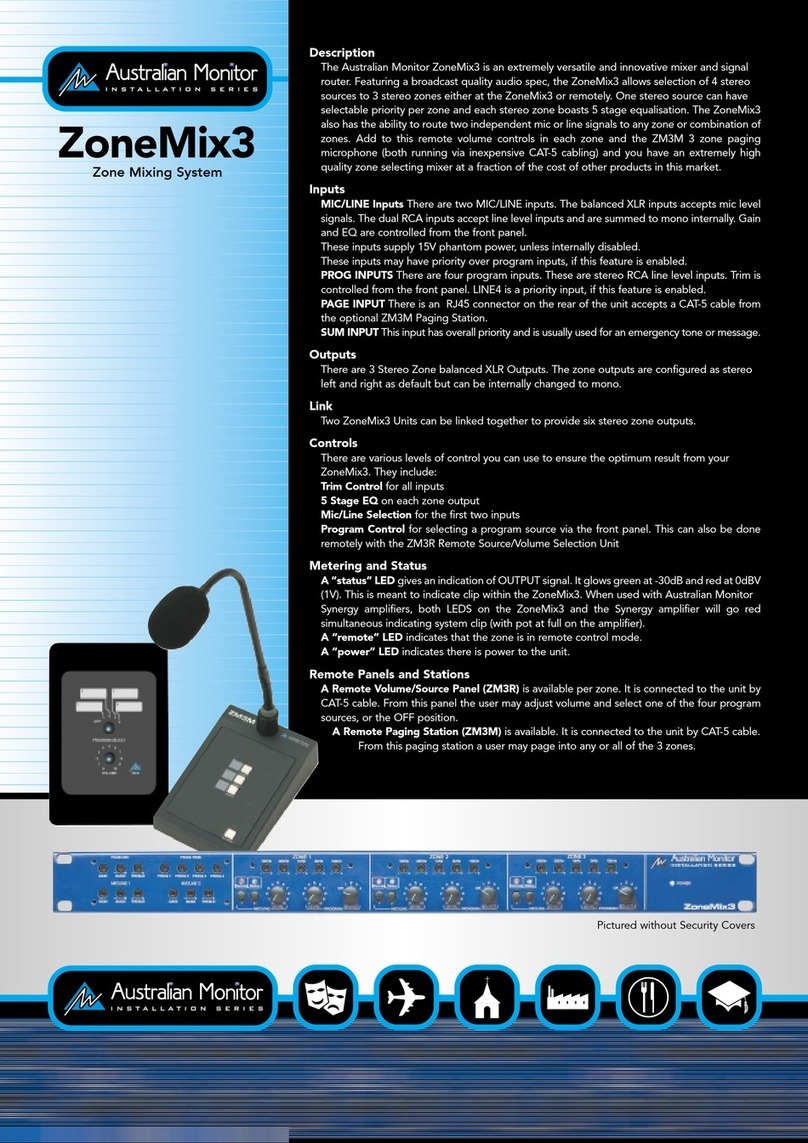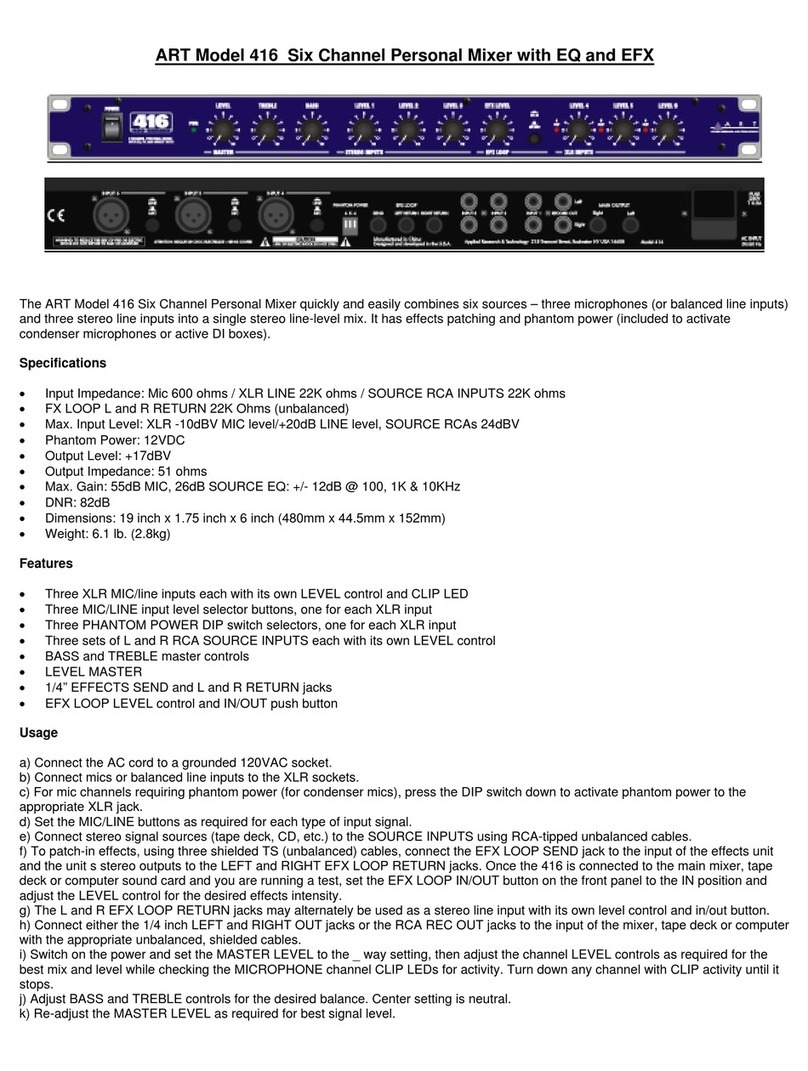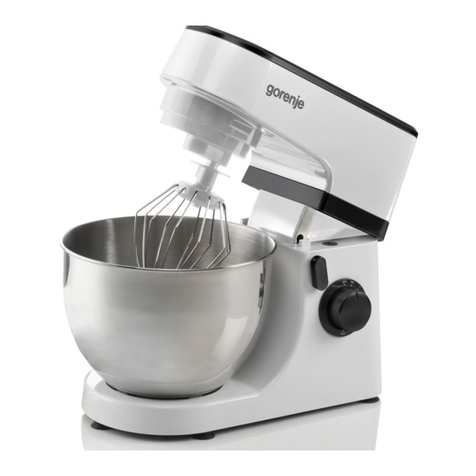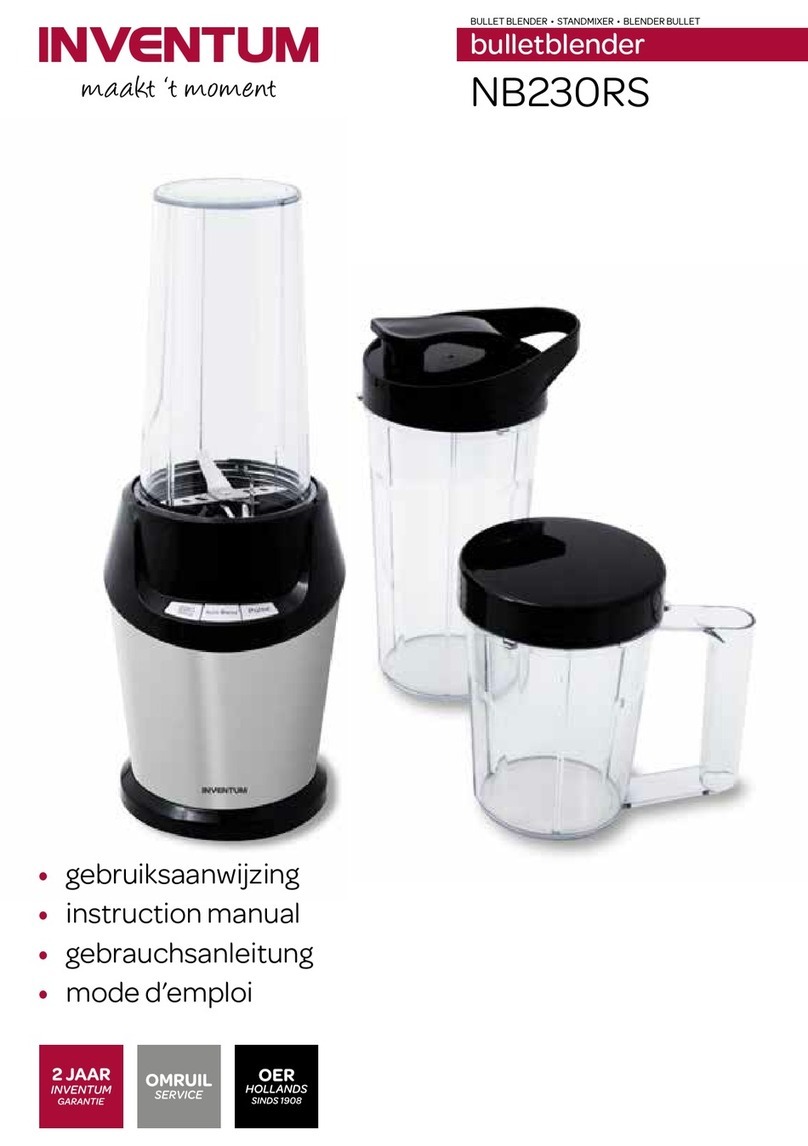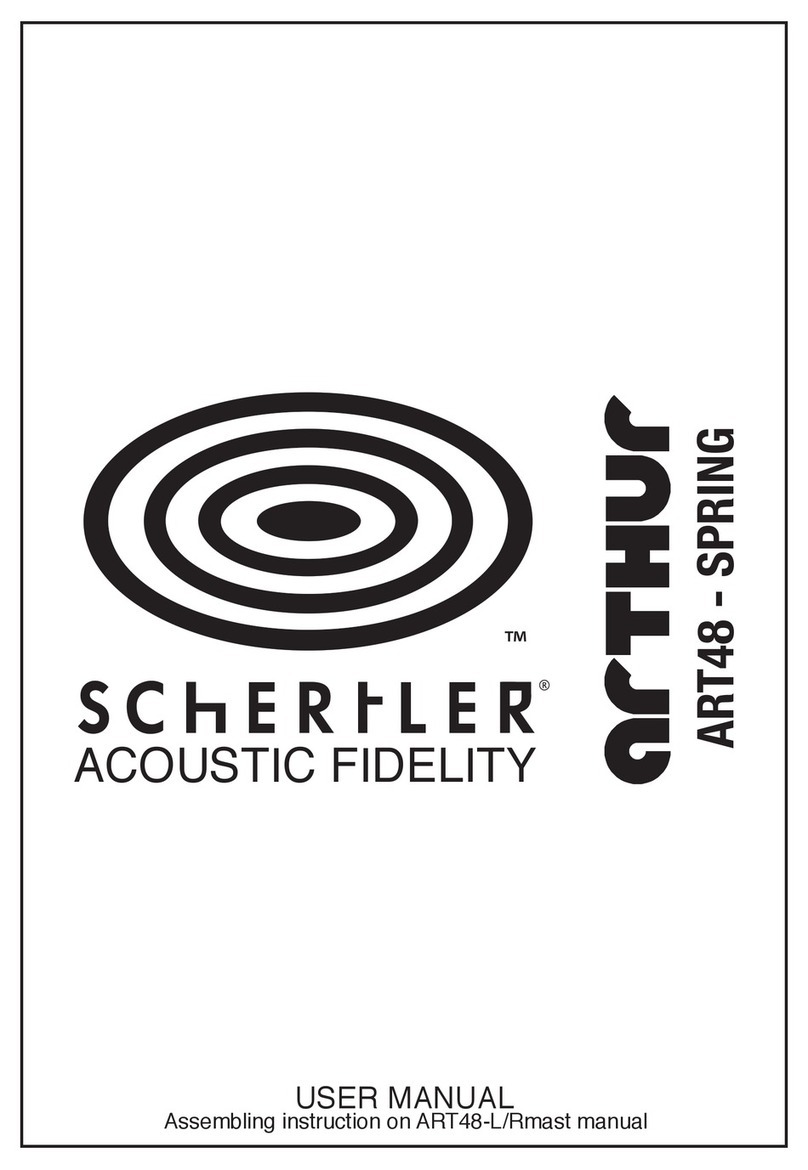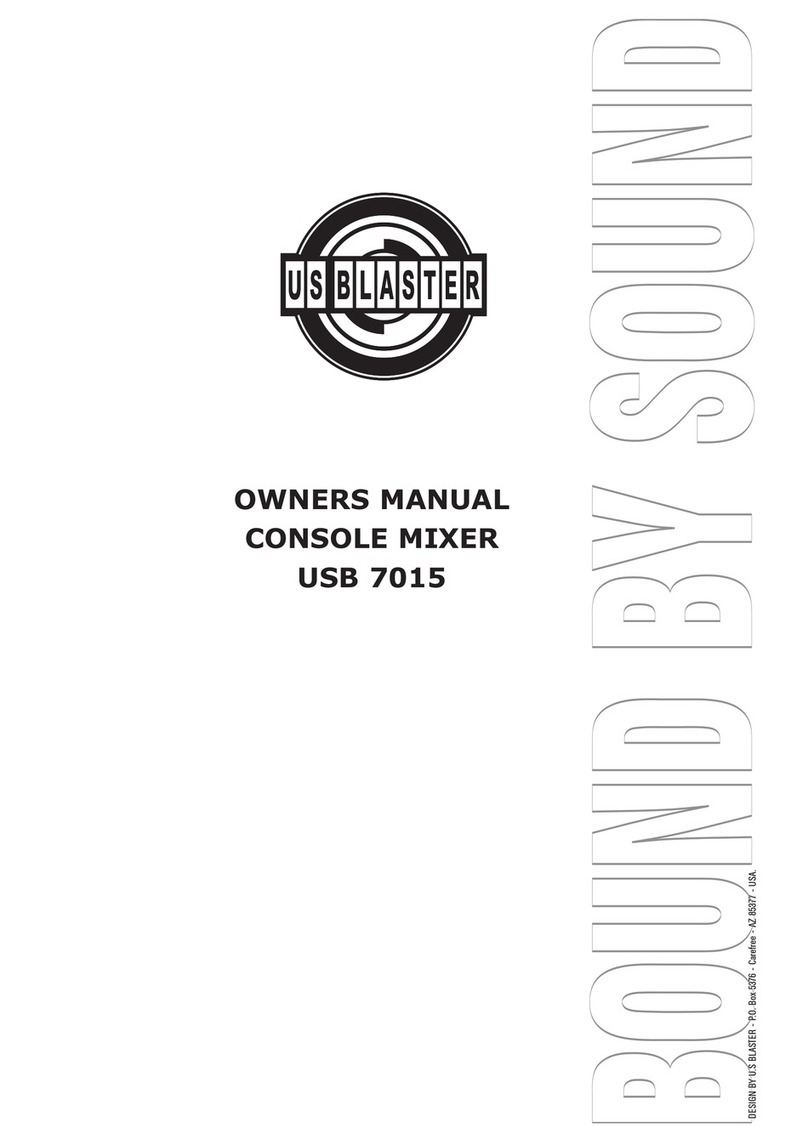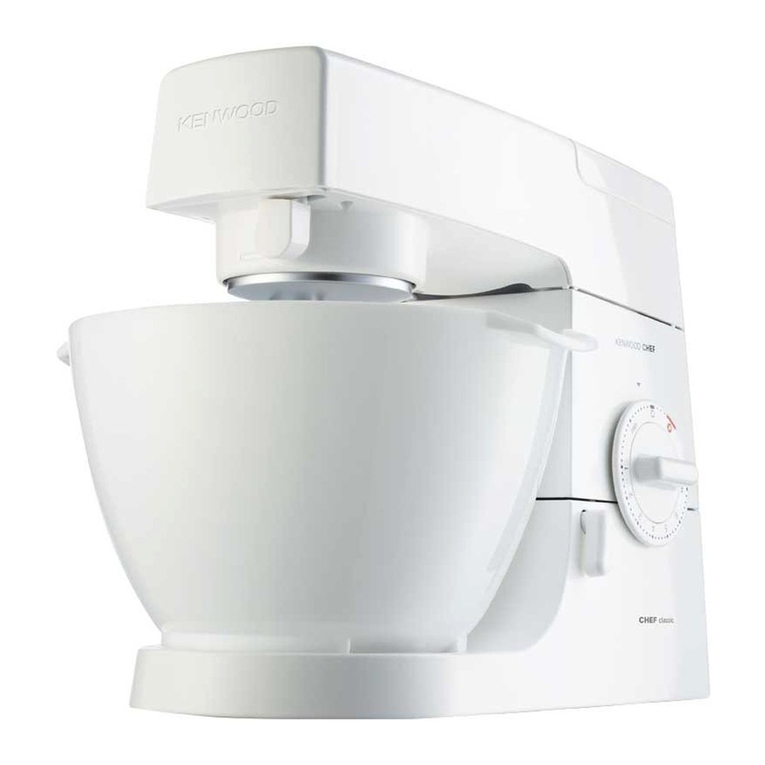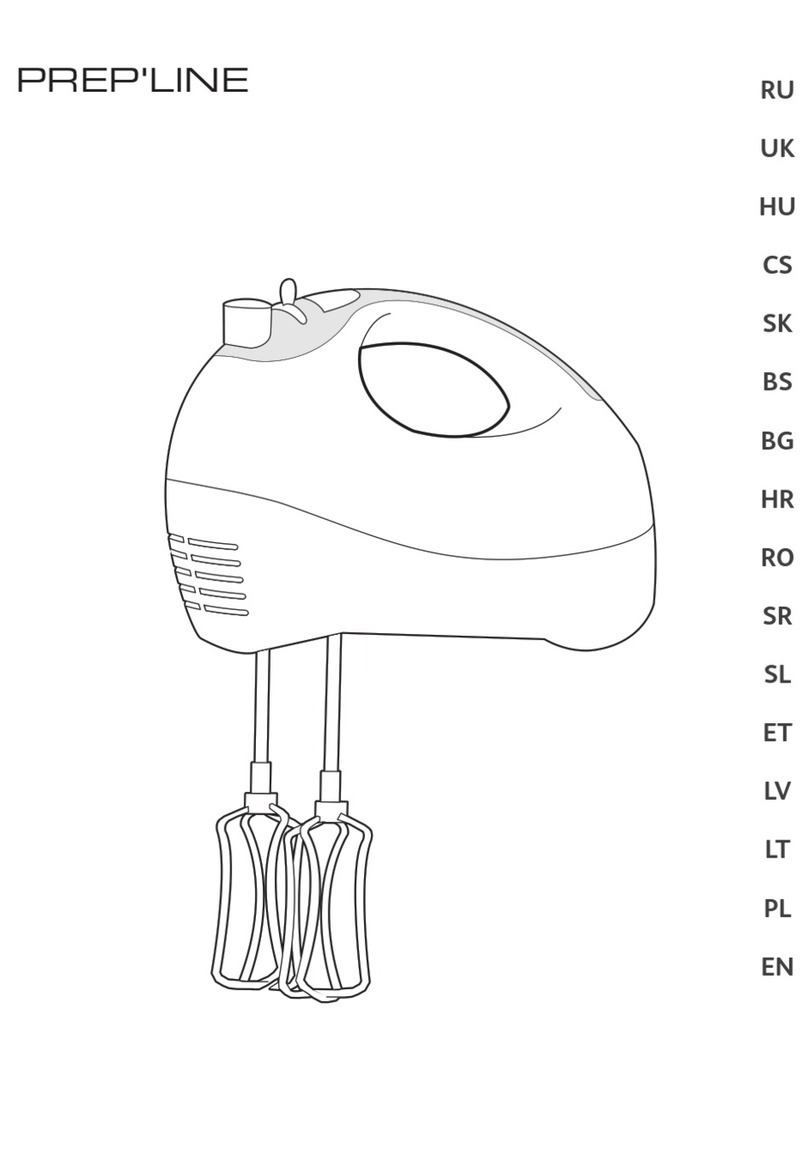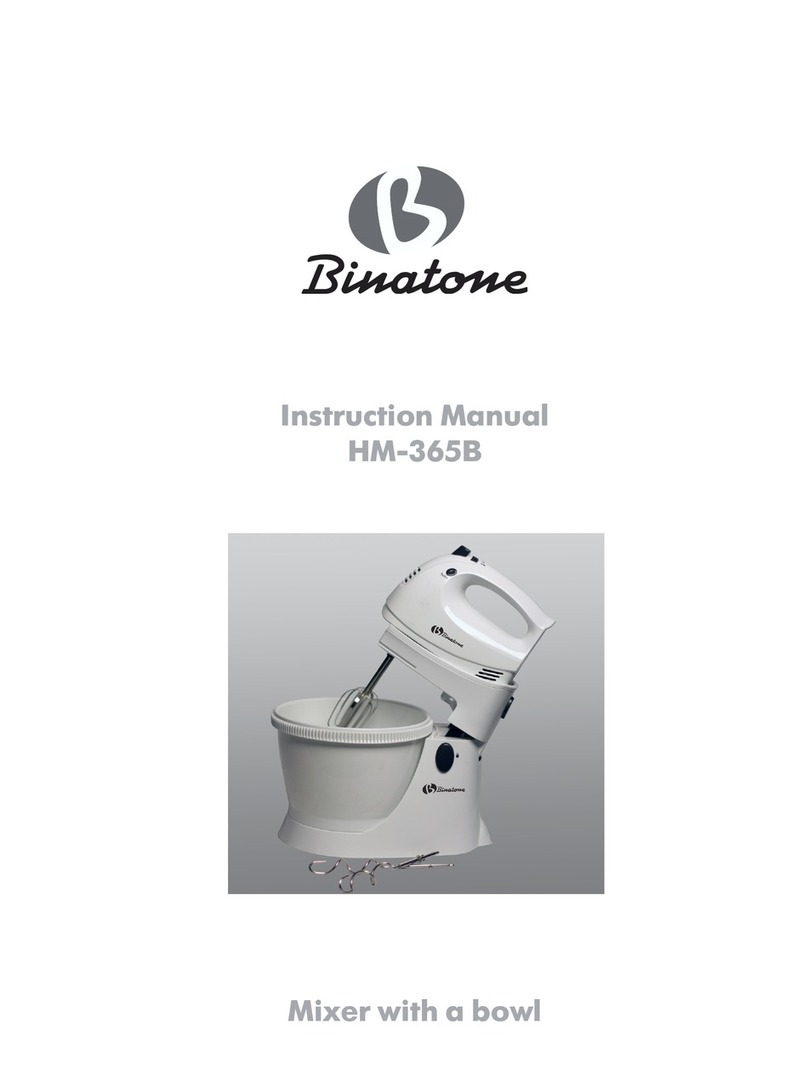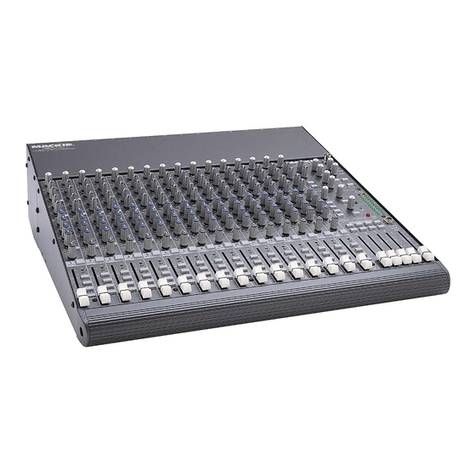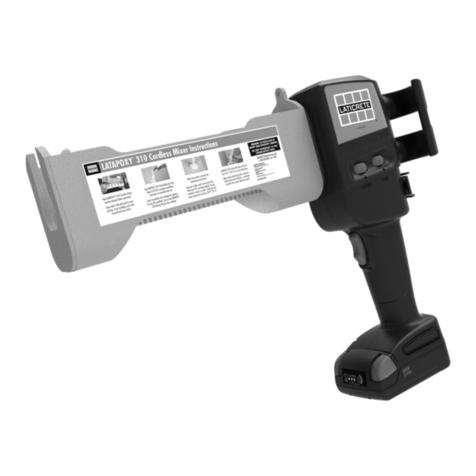IMER SPIN 15 Guide

IMER INTERNATIONAL S.p.A.
Via Salceto, 55 - 53036 POGGIBONSI (SI) -(ITALY)
Tel. 0577 97341 - Fax 0577 983304
www.imergroup.com
SPIN 15
SPIN 15A
( 1106100-1106101-1106102-
1106103-1106104-1106105-1106106 )
MESCOLATORE CONTINUO
MELANGEUR CONTINU
CONTINUOUS MIXER
DURCHLAUFMISCHER
MEZCLADOR CONTINUO
Manuale uso manutenzione e ricambi
Manuel utilisation entretien pieces de recharge
Operating,maintenance,spare parts manual
Handbuch fur Bedienung, Wartung und Ersatzteile
Manual de uso, mantenimiento y repuestos
3226807 R09- 12/2016

2
IMER INTERNATIONAL S.p.A.
SPIN 15
Particolare attenzione deve essere fatta alle avvertenze contrassegnate con questo simbolo:
Il faut prêter une attention toute particulière aux notes précédées de ce symbole :
Special attention must be given to warnings with this symbol:
Lesen Sie die mit diesem Symbol bezeichneten Abschnitte mit besonderer Aufmerksamkeit:
Se tiene que prestar una atención especial a las indicaciones marcadas con el signo:
ENGLISH
(1) WHEELED FRAME
(2) HOPPER
(3) MIXING CHAMBER
(4) MATERIAL OFFLOAD PORT
(5) ELECTRICAL PANEL
(6) AUGER TYPE BATCHING
SYSTEM
(7) GEARMOTOR
(8) MIXER
(9) WATER CIRCUIT
(10) HOPPER GRID
(11)WATER PUMP
FRANÇAIS
(1) CHASSIS SUR ROUES
(2) TREMIE
(3) CHAMBRE DE MALAXAGE
(4) BOUCHE DE DECHARGEMENT
MATERIAU
(5) TABLEAU ELECTRIQUE
(6) DOSEUR A VIS SANS FIN
(7) MOTOREDUCTEUR
(8) MELANGEUR
(9) INSTALLATION EAU
(10) GRILLE TREMIE
(11) POMPE
DEUTSCH
(1) RAHMEN MIT RÄDERN
(2) TRICHTER
(3) MISCHKAMMER
(4) MATERIALAUSLAUF
(4) WASSERANLAGE
(5) SCHALTTAFEL
(6) SCHNECKENDOSIERER
(7) GETRIEBEMOTOR
(8) MISCHER
(9) WASSERANLAGE
(10) TRICHTERGITTER
(11) PUMPE
ESPAÑOL
(1) BASTIDOR SOBRE RUEDAS
(2) TOLVA
(3) CÁMARA DE MEZCLADO
(4) BOCA DE SALIDA DE MATERIAL
(4) INSTALACIÓN DE AGUA
(5) CUADRO ELÉCTRICO
(6) DOSIFICADOR TORNILLO SIN
FIN
(7) MOTORREDUCTOR
(8) MEZCLADOR
(9) INSTALLACION DA AGUA
(10) REJILLA DE LA TOLVA
(11) BOMBA
ITALIANO
(1) TELAIO SU RUOTE
(2) TRAMOGGIA
(3) CAMERA DI MISCELAZIONE
(4) BOCCA DI SCARICO MATERIALE
(5) QUADRO ELETTRICO
(6) DOSATORE A COCLEA
(7)MOTORIDUTTORE
(8) MISCELATORE
(9) IMPIANTO ACQUA
(10)GRIGLIA TRAMOGGIA
(11)POMPA ACQUA
FIG.1

3
IMER INTERNATIONAL S.p.A.
SPIN 15
TABELLA - TABLEAU - TABLE - TABELLE - TABLA 1
I F GB D E SPIN 15-SPIN 15A
DATI TECNICI DONNEES TECHNIQUES TECHNICAL DATA TECHNISCHE DATEN DATO TECNICOS
Codice macchina Code machine Machine code Maschinencode Código de la máquina 1106100-110602-106104-1106106
230V/50Hz
Codice macchina Code machine Machine code Maschinencode Código de la máquina 1106101-110603-106105
230V/60Hz
ALIMENTAZIONE PRINCIPALE ALIMENTATION PRINCIPALE MAIN POWER SUPPLY HAUPTSTROMVERSORGUNG
ALIMENTACIÓN PRINCIPAL
V
Hz
230
50
V
Hz
220
60
COLLEGAMENTO IDRICO RACCORDEMENT HYDRIQUE WATER CONNECTION WASSERANSCHLUSS CONEXIÓN HÍDRICA 1/2"
MOTORIDUTTORE MOTORÉDUCTEUR GEARMOTOR GETRIEBEMOTOR MOTORREDUCTOR DEL
MEZCLADOR kW 1.4
POMPA ACQUA POMPE À EAU WATER PUMP WASSERPUMPE BOMBA DE AGUA kW 0.45
PRESSIONE MASSIMA PRESSION MAXIMUM MAXIMUM PRESSURE HHÖCHSTDRUCK PRESIÓN MÁXIMA bar 2.0
POTENZA MASSIMA PUISSANCE MAXIMUM MAXIMUM POWER MAX. LEISTUNG POTENCIA MÁXIMA kW 7.75
PORTATA MATERIALE (INDICATIVA)DÉBIT MATÉRIAU (INDICATIF ) MATERIAL FLOW RATE
(APPROX.)
MATERIALDURCHSATZ MIT
(RICHTWERT) CAUDAL DEL MATERIAL l/min 15
DIMENSIONI KOINE 4
X
Y
Z
DIMENSIONS
X
Y
Z
DIMENSIONS
X
Y
Z
ABMESSUNGEN
X
Y
Z
DIMENSIONES
X
Y
Z
mm
mm
mm
1380
720
1165-1095-950
ALTEZZA DI CARICAMETO
HUTEUR DE CHARGEMENT LOADING HEIGHT LADEHÖHE ALTURA DE CARGA mm 1165-1095-950
CAPACITA' TRAMOGGIA CAPACITÉ TRÉMIE HOPPER CAPACITY TRICHTERINHALT CAPACIDAD DE LA TOLVA l 60
PESO POIDS WEIGHT GEWICHT PESO kg
78
CON POMPA ACQUA AVEC POMPE WITH WATER PUMP MIT PUMPE CON BOMBA kg
85
LIVELLO EMISSIONE SONORA
LPA A1M- LWA-
EN ISO 3744
(2000/14/CE)
NIVEAU NUISANCE SONORE
LPA A 1M - LWA -
EN ISO 3744
(2000/14/CE)
NOISE EMISSION LEVEL
LPA A 1M - LWA -
EN ISO 3744
(2000/14/EC)
GERÄUSCHPEGEL
LPA IN 1M - LWA -
EN ISO 3744
(2000/14/EG)
RUIDO
LPA A 1M - LWA -
EN ISO 3744
(2000/14/CE)
dB(A) <76
88
NORME DI PROGETTO NORMES DE FABRICATION DESIGN STANDARDS PROJEKTNORMEN NORMAS DE PROYECTO
EN ISO 12100
EN 60204-1
EN 12001

4
IMER INTERNATIONAL S.p.A.
SPIN 15
'(6&5,=,21(0(6&2/$725(YHGL¿J
Il mescolatore è costituito da un telaio su ruote (rif.1), che sup-
porta una tramoggia (rif.2), una camera di miscelazione (rif.3), un
impianto acqua (rif.9), un quadro elettrico (rif.5).
Nella versione predisposta è presente anche una pompa per
l'acqua (rif. 11).
Il materiale premiscelato secco viene versato in tramoggia (con
sacchi o tramite altre apparecchiature), all'interno di questa, vi è
un dosatore a coclea (rif.6), azionato da un motoriduttore (rif.7),
che, movimentando il dosatore a coclea, trasporta il materiale
all'interno della camera di miscelazione. All'interno di questa, c'è
un miscelatore (rif.8), che collegato al dosatore a coclea, impasta
il materiale con l'acqua proveniente in camera di miscelazione
direttamente dalla pompa acqua e attraverso l'impianto idraulico.
Il materiale cosi miscelato viene convogliato alla bocca di scarico
(rif.4), pronto all' utilizzo verrà raccolto in casseri, cariole, secchi
ecc....quindi applicato manualmente ove richiesto.
5. SICUREZZA OPERATIVA
- Prima di utilizzare il mescolatore, accertarsi che sia
munito di tutti i dispositivi di protezione.
- E' vietato introdurre parti del corpo e/o utensili nella
tramoggia o nella bocca di scarico con macchina in funzione.
-8WLOL]]DUHLOPHVFRODWRUHVHPSUHLQDPELHQWLVXI¿FHQ-
temente ventilati.
Nell’area di lavoro devono essere osservate le norme per la
prevenzione degli infortuni nonchè le disposizioni di sicurezza.
Occorre fare attenzione durante la manipolazione dei sacchi di
materiale a non sollevare polvere per evitare di inalarne; se ciò
non fosse possibile è necessario indossare una maschera per la
protezione della bocca e del naso.
- Non deve essere usata in ambienti ove esista pericolo
di esplosioni, incendi e in ambienti di scavi sotterranei.
Il mescolatore non dispone di illuminazione propria e pertanto il
OXRJRGLODYRURGHYHHVVHUHVXI¿FHQWHPHQWHLOOXPLQDWR
Le linee di alimentazione devono essere posate in modo tale da
non poter essere danneggiate. Non collocare il mescolatore sopra
il cavo di alimentazione elettrica.
L'allacciamento elettrico deve essere tale da impedire la pene-
trazione di acqua nei connettori. Impiegare soltanto connettori ed
attacchi muniti di protezione contro gli spruzzi d’acqua.
- Non utilizzare linee elettriche inadeguate, provvisorie: eventual-
mente consultarsi con personale specializzato.
- Le riparazioni degli impianti elettrici devono essere eseguite
esclusivamente da personale specializzato. Sconnettere la
macchina dall'alimentazione prima di eseguire le operazioni di
manutenzione o riparazione.
-
Evitare che i conduttori elettrici possano andare a contatto con
parti mobili e/o in movimento della macchina. Lesionandosi possono
mettere in tensione parti metalliche.
Attenzione!
Non inserire le mani nella boccheta di scarico.
6.SICUREZZA ELETTRICA
Il mescolatore SPIN15 è realizzato secondo le norme EN 60204-1,
è protetto contro gli spruzzi d'acqua ed è dotato di protezione contro
i sovraccarichi e la mancanza di tensione.
Il mescolatore deve essere collegato al circuito di terra.
Per agevolarne il trasporto la macchina puo essere scomposta
FRPHLQGLFDWRLQ¿J
Gentile Cliente,
ci complimentiamo per il suo acquisto: Il mescolatore IMER, risul-
WDWRGLDQQLGLHVSHULHQ]DqXQDPDFFKLQDGLPDVVLPDDI¿GDELOLWj
e dotata di soluzione tecniche innovative.
- OPERARE IN SICUREZZA.
(¶IRQGDPHQWDOHDL¿QLGHOODVLFXUH]]DOHJJHUHDWWHQWDPHQWH
le seguenti istruzioni.
Il presente manuale di USO E MANUTENZIONE deve essere
custodito dal responsabile di cantiere, nella persona del Ca-
pocantiere, nel cantiere stesso, sempre disponibile per la sua
consultazione.
Il manuale è da considerarsi parte della macchina e deve essere
FRQVHUYDWRSHUIXWXULULIHULPHQWL(1,62¿QRDOODGLVWUX-
zione della macchina stessa. In caso di danneggiamento o smar-
rimento potrà essere richiesto al costruttore un nuovo esemplare.
Il manuale contiene la dichiarazione di conformità CE 2006/42/
CE ed importanti indicazioni sulla preparazione del cantiere,
l’installazione, l’uso, le modalità di manutenzione e la richiesta
di parti di ricambio. Comunque è da ritenersi indispensabile una
adeguata esperienza e conoscenza della macchina da parte del
l’utilizzatore:l'utilizzatore deve essere addestrato da una persona
perfettamente a conoscenza dell'impiego delle modalità di utilizzo
della macchina.
$I¿QFKq VLD SRVVLELOH JDUDQWLUH OD VLFXUH]]D GHOO¶RSHUDWRUH OD
sicurezza di funzionamento e una lunga durata della macchina
devono essere rispettate le istruzioni del manuale, unitamente
alle norme di sicurezza e prevenzione degli infortuni sul lavoro
secondo la legislazione vigente (uso di calzature e abbigliamento
adeguati, uso di elmetti, guanti, occhiali, ecc.).
- Mantenere sempre leggibili le avvertenze.
(¶YLHWDWRDSSRUWDUHPRGL¿FKHGLTXDOVLDVLQDWXUDDOOD
struttura metallica o impiantistica del mescolatore.
IMER INTERNATIONAL declina ogni responsabilità su danni o
difetti provocati da macchinari o aparecchiature non fornite da
IMER e che vengono combinate con le propie macchine.
IMER INTERNATIONAL declina ogni responsabilità in caso di
non osservanza delle leggi che regolano l’uso di tali apparecchi,
in particolare: uso improprio, difetti di alimentazione, carenza di
PDQXWHQ]LRQHPRGL¿FKHQRQDXWRUL]]DWHLQRVVHUYDQ]DSDU]LDOH
o totale delle istruzioni contenute in questo manuale.
,0(5,17(51$7,21$/KDLOGLULWWRGLPRGL¿FDUHOHFDUDWWHULVWLFKH
del mescolatore e/o i contenuti del presente manuale, senza l’ob-
bligo di aggiornare la macchina e/o i manuali precedenti.
1. DATI TECNICI
Nella tabella 1 sono riportati i dati tecnici del mescolatore, facendo
ULIHULPHQWRDOOD¿JXUD
2. NORME DI PROGETTO
I mescolatori continui, sono stati progettati e costruiti applicando
le norme indicate in tabella 1.
3. LIVELLO EMISSIONE SONORA
In tabella 1 sono riportati il livello di pressione sonora del mesco-
latore misurato all'orecchio dell'operatore (LpA a 1 m) ed livello di
emissione sonora nell'ambiente (potenza LWA) misurato secondo
EN ISO 3744 (2000/14/CE).
4. DESCRIZIONE FUNZIONAMENTO MESCOLATORE
- IL MESCOLATORE CONTINUO ORIZZONTALE è destina-
to per l'impiego nei cantieri edili, per impastare tutte le malte
premiscelate dichiarate miscelabili con queste tipologie di
macchine dai produttori di materiali: malte da muratura, malte
per massetti semiasciutti, betoncini, intonaci a base calce/
cemento/gesso, malta per stuccatura di fughe ecc.
ISTRUZIONI ORIGINALI

5
IMER INTERNATIONAL S.p.A.
SPIN 15
9. INSTALLAZIONE
3RVL]LRQDUHLOPHVFRODWRUHDOSLDQRLQXQDPELHQWHVXI¿FHQWH-
mente ventilato dove non crei intralcio, ne durante l'utilizzo, ne
SHUODSXOL]LDD¿QHODYRUR
- L'impastatore dovra essere posizionato in piano o leggermente
inclinato verso la bocca di scarico del materiale.
10. ALLACCIAMENTI
$//$&&,$0(172(/(775,&2YHGL¿J
9HUL¿FDUHFKHODWHQVLRQHGLDOLPHQWD]LRQHODIUHTXHQ]D
GLUHWHHLOFROOHJDPHQWRHOHWWULFRSUHVDIXVLELOLFDYRVLDQR
conformi ai dati riportati in tab.1.
La presa di alimentazione elettrica deve essere provvista di
protezione contro le sovracorrenti (es. con fusibili o con un
interruttore magnetotermico) e contro le correnti di dispersione
verso massa(es:con un interruttore tipo differenziale). Il dimensio-
namento dei conduttori del cavo di alimentazione elettrica deve
tener conto delle correnti di funzionamento e della lunghezza della
linea per evitare eccessive cadute di tensione.
Evitare l’impiego di prolunghe avvolte a spire sui tamburi. Il con-
duttore di alimentazione deve essere del tipo adatto per frequenti
movimenti e rivestimento resistente all'abrasione
(per esempio H07RN-F).
3ULPDGLFROOHJDUHHOHWWULFDPHQWHLOPHVFRODWRUHYHUL¿FDUHFKH
tutti i dispositivi di sicurezza siano a posto ed in buono stato d'uso,
ed in particolare la griglia tramoggia sia presente e regolarmente
¿VVDWDFKHODSUROXQJDVLDLQEXRQRVWDWRHFKHOHVSLQHHSUHVH
non siano bagnate.
Collegare l'alimentazione alla spina del mescolatore posta sul
TXDGURHOHWWULFR¿J
6,&85(==$0(&&$1,&$YHGL¿J
Nel mescolatore IMER, i punti pericolosi sono protetti mediante
opportuni dispositivi di protezione, che, devono essere mantenuti
in perfette condizioni e montati. Ad esempio, la protezione della
ventola di raffreddamento dei motori elettrici e la griglia della
tramoggia (rif.10), che impedisce il contatto con la coclea.
Inoltre, lo sgancio della camera di miscelazione comporta l'imme-
diato arresto ed isolamento di tutte le parti in rotazione, grazie ad
XQHI¿FDFHHGRSSRUWXQRGLVSRVLWLYRGLVLFXUH]]D
75$63257$%,/,7$YHGL¿JH¿J
- ATTENZIONE! Prima di spostare il mescolatore, scollegare
sempre la spina di alimentazione.
Prima di spostare il mescolatore è opportuno scollegare il tubo di
alimentazione dell' acqua.
E' necessario che vi sia meno materiale possibile in tra-
moggia.
6ROOHYDUHLOPHVFRODWRUHDYYDOHQGRVLGHOOHDSSRVLWHPDQLJOLH¿J
e spingere nella direzione desiderata.
-ATTENZIONE! Prima di sollevare il mescolatore, cotrollare
che tutti i componenti della macchina siano correttamente
EORFFDWLH¿VVDWLHQRQYLVLDQRDSSRJJLDWLVRSUDDOWULRJJHWWL
- ATTENZIONE! Il sollevamento deve essere fatto con pru-
denza, la macchina potrebbe oscillare
- ATTENZIONE! Per il sollevamento della macchina non
XWLOL]]DUHSXQWLGLDJJDQFLRGLYHUVLGDTXHOOLLQGLFDWLLQ¿J
Per il sollevamento della macchina utilizzare i due anelli apposi-
WDPHQWHSUHYLVWL¿J

6
IMER INTERNATIONAL S.p.A.
SPIN 15
FIG. 6
$//$&&,$0(172$&48$YHGL¿J
Collegare il tubo dell'acqua (tab.1) alla rete idrica o ad un fusto se
si dispone della versione dotata della pompa dell'acqua.
- Con mescolatore senza pompa acqua, la rete idrica deve
garantire una portata minima di almeno 20 l/min e una pressione
minima di 2 bar.
- Con mescolatore con pompa acqua se la pompa non è
alimentata da acqua si brucia la guarnizione di tenuta.
- Se in presenza della pompa acqua, l'acqua è prelevata
da un fusto, assicurarsi che il livello dell'acqua sia superiore
di almeno 1Mt rispetto a quello della pompa.
$/7(==(',&$5,&29(',),*
Il' mescolatore continuo SPIN15 ha la possibilità di poter lavorare
a tre altezze diverse.
I piedi possono scorrere all'interno del telaio prima di essere
bloccati con delle copiglie ad altezze prestabilite e questo dà la
possibilità di avere tre diverse altezze di carico:
1) Carico diretto materiale su intonacatrice del tipo SMALL50;
2) Carico diretto materiale su cariola;
3) Carico diretto materiale su secchio di lavoro.
12. MESSA IN MARCIA
- Durante il lavoro avviare ed arrestare il mescolatore
utilizzando solo i pulsanti ON/OFF.
- Caricare il materiale premiscelato secco. Prendere i sacchi di
materiale appoggiarli in modo deciso alla griglia rompisacco
ULI¿JVROOHYDUHOHGXHHVWUHPLWjGHOVDFFR¿QRDVYXRWDUOR
FRPSOHWDPHQWHDOOLQWHUQRGHOODWUDPRJJLD¿J
-A questo punto posizionare sotto la bocca di scarico del materiale
una portantina o un recipiente idoneo ed avviare il mescolatore
tramite l'interruttore ON/OFF. La macchina è in funzionamento
di lavoro.
Per ottenere la consistenza desiderata del materiale:
Ottimizzare la quantità d'acqua agendo sul rubinetto quando il
mescolatore è in funzione
Fare piccoli spostamenti frazionati, di circa 1/2 giro ogni 15 secondi.
La macchina è dotata di protezione contro la mancanza di ten-
VLRQHQHOFDVRLQFXLVLYHUL¿FKLQRDFFLGHQWDOPHQWHTXHVWLHYHQWL
è necessario premere il pulsante ON per riavviare la macchina.
In caso di emergenza per arrestare la macchina premere il pulsan-
te rosso (OFF): si arrestano tutti gli organi in movimento.Quindi
staccare la presa di alimentazione elettrica.
PROTEZIONE TERMICA:
- Il motore elettrico è protetto da sovraccarichi da un re-
set termico il cui intervento è determinato dallo spegnimento
dello stesso durante il lavoro. In tal caso, fatti raffreddare i
motori, si deve riarmare l'interruttore ON/OFF per ripartire.
13. MODALITÀ D'USO
- La griglia di sicurezza della tramoggia deve essere
VHPSUHSUHVHQWHHFRUUHWWDPHQWH¿VVDWD
- Indossare le protezioni individuali previste prima di
cominciare ad operare.
13.1 Pause durante il lavoro
Le interruzioni superiori a 30min dovrebbero essere evitate.
Un arresto prolungato può provocare un intasamento nella camera
di miscelazione
Qualora non uscisse materiale dalla bocca di scarico è necessario
effettuarne la pulizia. Arrestare la macchina e procedere come
descritto nel paragrafo 14, rimontare ed avviare nuovamente.
38/,=,$($55(672'(/0(6&2/$725(YHGL¿J
$OOD¿QHGHOODYRURVSHJQHUHODPDFFKLQDWUDPLWHOLQWHUUXWWRUH
ON/OFF, scollegare la presa di alimentazione, chiudere la man-
data dell'acqua, aprire il rubinetto ausiliario e staccare il tubo di
alimentazione acqua.
Togliere la camera di miscelazione (rif.1) ruotandola per liberarla
dai ganci (rif.2), assieme alla camera di miscelazione si toglie
anche l'albero (rif.3)
Svuotare e pulire la camera di miscelazione e il miscelatore con
acqua e asciugarli entrambi con carta.
Rimontare l'albero nella propria sede dopo aver accertato che
TXHVWDVLDSXOLWDDVHJXLWRLQ¿ODUHODFDPHUDGLPLVFHOD]LRQHHG
agganciarla in modo corretto.
Prima di riavviare la macchina è importante, richiudere i rubinetti.
Nel caso in cui si preveda di non utilizzare la macchina per diversi
giorni, svuotare completamente la tramoggia.
- Attenzione ! Prima di smontare il mescolatore o di
rimuovere la griglia è obbligatorio mettere l'interruttore
principale a OFF e staccare la presa di alimentazione della
macchina.

7
IMER INTERNATIONAL S.p.A.
SPIN 15
0$187(1=,21(YHGL¿J
- Le operazioni di manutenzione devono essere ese-
guite da personale esperto, dopo aver spento la macchina,
scollegato l'alimentazione elettrica e svuotato la tramoggia.
&RQWUROODUHJLRUQDOPHQWHFKHLO ¿OWUR GHOODFTXD WDEULI VLD
pulito.
Controllare settimanalmente che l'albero di miscelazione sia in
buono stato ed eventualmente sostituirlo (rif.8)
Controllare settimanalmente che i motori elettrici siano esenti
da polvere e sporcizia e se necessario pulirli utilizzando dell'aria
compressa.
Controllare settimanalmente che i contatti delle spine e delle prese
siano siano ben puliti, asciutti e privi di ossidazioni.
Una volta ogni sei mesi far controllare la macchina presso un
punto di assistenza autorizzato IMER.
-
/¶ROLRHVDXVWRqUL¿XWRVSHFLDOH&RPHWDOHYDVPDOWLWR
secondo i termini di legge.
-
Mantenere sempre leggibili le scritte e le segnalazioni
poste sulla macchina.
-
0DQWHQHUHVHPSUHHI¿FLHQWLWXWWLLGLVSRVLWLYLGLSURWH]LRQH

8
IMER INTERNATIONAL S.p.A.
SPIN 15
'(6&5,37,210(/$1*(85YRLU¿J
Le mélangeur se compose d’un châssis sur roues (réf.1), qui
supporte une trémie (réf.2), une chambre de malaxage (réf.3),
une installation eau (réf. 9), un tableau électrique (réf.5).
Il y a une version de melangeur horizontale avec la pompe à eau
déjà montée (réf. 11).
Le matériau pré-mélangé sec est versé en trémie (avec sacs
ou d’autres appareils) ; à l’intérieur de cette dernière se trouve
XQGRVHXUjYLVVDQV¿QUpIDFWLRQQpSDUXQPRWRUpGXFWHXU
UpITXLHQIDLVDQWERXJHUOHGRVHXUjYLVVDQV¿QWUDQVSRUWH
le matériau à l’intérieur de la chambre de malaxage. A l’intérieur
de la chambre se situe un mixeur (réf. 8) qui, relié au doseur à
YLVVDQV¿QSpWULWOHPDWpULDXDYHFO¶HDXSURYHQDQWHQFKDPEUH
de malaxage directement de la pompe à eau et à travers l’instal-
lation hydraulique.
Le matériau ainsi mélangé est convoyé vers la bouche de déchar-
gement (réf. 4), prêt à l’emploi ; il sera récolté en coffrages, brou-
ettes, seaux etc puis appliqué manuellement à l’endroit désiré.
5. SECURITE DU TRAVAIL
-$YDQWG¶XWLOLVHUOHPpODQJHXUYpUL¿HUTX¶LOHVWpTXLSp
de tous les dispositifs de protection.
- Il est interdit d’introduire des parties du corps et/ou
des outils dans la trémie ou dans la bouche de déchargement
lorsque la machine est en marche.
-8WLOLVHUOHPpODQJHXUGDQVGHVHQGURLWVVXI¿VDPPHQW
ventilés.
Les normes de prévention des accidents du travail et les consignes
de sécurité doivent être respectées sur le lieu de travail.
Faire attention durant la manipulation des sacs de matériau ;
ne pas soulever de poudre pour éviter de l’inhaler ; Dans le cas
contraire, porter un masque pour se protéger la bouche et le nez.
- Ne pas l’utiliser dans des milieux avec danger d’explo-
sion, d’incendie ou dans des milieux de fouilles souterraines.
Le mélangeur ne dispose pas d’éclairage propre et donc le lieu
GHWUDYDLOGRLWrWUHVXI¿VDPPHQWLOOXPLQp
Les lignes d’alimentation doivent être posées de façon à ne pas
pouvoir être endommagées. Ne pas installer le mélangeur au-
dessus du câble d’alimentation électrique.
Le branchement électrique doit être réalisé de façon à empêcher
l’eau de pénétrer dans les connecteurs. N’utiliser que des con-
necteurs et des prises munis de systèmes de protection contre
les éclaboussures d’eau.
- Ne pas utiliser de lignes électriques inappropriées, provisoires :
éventuellement, contacter le personnel spécialisé.
- Les réparations des systèmes électriques doivent être exécutées
H[FOXVLYHPHQWSDUGXSHUVRQQHOTXDOL¿p'pFRQQHFWHUODPDFKLQH
de l’alimentation avant de réaliser les opérations d’entretien ou
de réparation.
-
Eviter que les conducteurs électriques n’entrent en contact avec les
pièces mobiles et/ou en mouvement de la machine. En s’usant, ils
peuvent mettre sous tension des pièces métalliques.
-ATTENTION!
Ne pas mettre le mains dans la bouche
d’evacuation
6.SECURITE ELECTRIQUE
Le mélangeur SPIN15 est réalisé selon les normes EN 60204-1 ; il est
protégé contre les éclaboussures d’eau et est équipé de protection
contre les surcharges et le manque de tension.
Le mélangeur doit être relié au circuit de terre.
Pour faciliter son transport, la machine peut être décomposée
FRPPHLQGLTXpVXUOD¿J
Cher client,
IpOLFLWDWLRQVSRXUYRWUHDFKDW/HPpODQJHXU,0(5JUkFHjGHV
DQQpHVG¶H[SpULHQFHHVWXQHPDFKLQHTXLJDUDQWLWXQH¿DELOLWp
totale et présente des solutions technique innovantes
- COMMENT TRAVAILLER EN TOUTE SECURITE.
Pour garantir une sécurité totale, il est fondamental de lire
attentivement les instructions qui suivent.
Le présent manuel d’UTILISATION et d’ENTRETIEN doit être con-
servé par le responsable de chantier, à savoir le chef de chantier,
et toujours être disponible pour sa consultation.
Il doit être considéré comme partie intégrante de la machine et doit
être conservé pour les références futures(EN ISO 12100) jusqu’à
la destruction de la machine. En cas d’endommagement ou de
perte, un nouvel exemplaire pourra être demandé au fabricant.
Le manuel renferme la déclaration de conformité CE 2006/42/CE
et d’importantes consignes pour la préparation du chantier, l’instal-
lation, l’utilisation, les modalités d’entretien et l’approvisionnement
de pièces détachées. Cependant, une expérience appropriée et
une bonne connaissance de la machine de la part de l’utilisateur
sont à considérer comme indispensables. L’utilisateur doit être
formé par une personne connaissant parfaitement les modalités
d’utilisation de la machine.
$¿QTX¶LOVRLW SRVVLEOHGHJDUDQWLU ODVpFXULWpGH O¶RSpUDWHXU OD
sécurité de fonctionnement et la longue durée de la machine, il est
nécessaire de respecter les instructions du manuel, les normes de
sécurité et de prévention des accidents de travail conformément à
la législation en vigueur (port de chaussures et d’un habillement
appropriés, emploi de casques, de gants, de lunettes, etc.).
- Faire en sorte que les avertissements soient toujours
lisibles.
,O HVW LQWHUGLW G¶HIIHFWXHU WRXWH PRGL¿FDWLRQ TXHOOH
qu’elle soit sur la structure métallique ou sur les systèmes
du mélangeur.
IMER INTERNATIONAL décline toute responsabilité en cas de
dommages ou défauts provoqués par des machines ou appareils
non fournis par IMER et qui sont combinés avec ses machines.
IMER INTERNATIONAL décline toute responsabilité en cas de
non-respect des réglementations régissant l’utilisation de ces ap-
pareils, notamment : utilisation incorrecte, défauts d’alimentation,
PDQTXH G¶HQWUHWLHQ PRGL¿FDWLRQV QRQ DXWRULVpHV QRQUHVSHFW
total ou partiel des consignes données dans ce manuel.
,0(5,17(51$7,21$/VHUpVHUYH OHGURLW GHPRGL¿HU OHVFD-
ractéristiques du mélangeur ou les contenus de ce manuel, sans
s’engager à mettre à jour la machine et/ou les manuels précédents.
1. CARACTERISTIQUES TECHNIQUES
Le tableau 1 contient les données techniques du mélangeur, en
UpIpUHQFHjOD¿JXUH
2. NORMES DE FABRICATION
Les mélangeurs continus ont été conçus et construits en appli-
quant les normes indiquées dans le tableau 1.
3. NIVEAU DE PUISSANCE SONORE
Le tableau 1 indique le niveau de pression sonore du mélangeur
mesuré à l’oreille de l’opérateur (LpA à 1 m) et le niveau d’émission
sonore dans le milieu (puissance LWA) mesuré selon EN ISO 3744
(2000/14/CE)
4. DESCRIPTION FONCTIONNEMENT MELANGEUR
- LE MELANGEUR CONTINU HORIZONTAL est destiné
aux chantiers de construction, pour combiner tous les
mortiers prémélangés pouvant être amalgamés avec ces
typologies de machines sur déclaration des producteurs
de matériaux : mortiers de maçonnerie, mortiers pour blocs
VHPLVHFVEpWRQVÀXLGHVHQGXLWVjEDVHGHFKDX[FLPHQW
plâtre, mortiers pour jointoiements etc.
INSTRUCTIONS ORIGINALES

9
IMER INTERNATIONAL S.p.A.
SPIN 15
9. INSTALLATION
Positionner le mélangeur en plan, dans un milieu opportunément
ventilé, ne créant pas d’obstacle durant l’utilisation ni lors du
QHWWR\DJHjOD¿QGXWUDYDLO
- Le mixeur devra être positionné en plan ou légèrement incliné
vers la bouche de déchargement du matériau.
10. BRANCHEMENTS
%5$1&+(0(17(/(&75,48(YRLU¿J
9pUL¿HUTXHODWHQVLRQG¶DOLPHQWDWLRQODIUpTXHQFHGH
UpVHDXHWOHEUDQFKHPHQWpOHFWULTXHSULVHIXVLEOHVFkEOH
sont conformes aux données du tab.1.
La prise d’alimentation électrique doit être équipée de protection
contre les surintensités (ex. avec des fusibles ou avec un inter-
rupteur magnétothermique) et contre les courants de dispersion
vers la masse (ex: avec un interrupteur de type différentiel). Les
dimensions des conducteurs du câble d’alimentation électrique
doivent tenir compte des courants de fonctionnement et de la
longueur de la ligne pour éviter des chutes de tension excessives.
Evitez d’utiliser des rallonges enroulées en spires sur les tam-
bours. Le conducteur d’alimentation doit être de type approprié
pour les mouvements fréquents et avoir un revêtement résistant
à l’abrasion
(par exemple H07RN-F).
$YDQWGHUHOLHUpOHFWULTXHPHQWOHPpODQJHXUYpUL¿HUTXHWRXVOHV
dispositifs de sécurité sont en place et en bon état ; en particulier
TXH OD JULOOH WUpPLH HVW SUpVHQWH HW FRUUHFWHPHQW ¿[pH TXH OD
UDOORQJHHVWHQERQpWDWHWTXHOHV¿FKHVHWOHVSULVHVQHVRQW
pas mouillées.
5DFFRUGHU O¶DOLPHQWDWLRQ j OD ¿FKH GX PpODQJHXU VLWXpH VXU OH
WDEOHDXpOHFWULTXH¿J
6(&85,7(0(&$1,48(YRLU¿J
Dans le mélangeur IMER, les points dangereux sont protégés
au moyen de dispositifs spéciaux de protection qui doivent être
maintenus dans de parfaites conditions et montés. Par exemple
la protection du ventilateur de refroidissement des moteurs élec-
triques et la grille de la trémie (réf. 10) qui empêche le contact
DYHFODYLVVDQV¿Q
En outre, le décrochage de la chambre de malaxage comporte
l’arrêt immédiat et l’isolation de toutes les pièces en rotation, grâce
jXQGLVSRVLWLIGHVpFXULWpHI¿FDFHHWRSSRUWXQ
75$163257YRLU¿JHW¿J
- ATTENTION ! Avant de déplacer le mélangeur, déconnecter
OD¿FKHG¶DOLPHQWDWLRQ
Avant de déplacer le mélangeur, déconnecter le tuyau d’alimen-
tation de l’eau.
De plus, il faut qu’il y ait le moins de matériau possible en trémie.
Soulever le mélangeur au moyen des poignées spéciales
¿JHWSRXVVHUGDQVODGLUHFWLRQVRXKDLWpH
-ATTENTION ! Avant de soulever le mélangeur, con-
trôler toujours que tous les composants de la machine sont
FRUUHFWHPHQWEORTXpVHW¿[pVHWTX¶DXFXQREMHWQ¶HVWSRVp
dessus.
- ATTENTION ! Le levage doit être effectué prudemment car
la machine peut osciller.
- ATTENTION ! Pour le levage de la machine, n’utiliser sous
aucun prétexte des points d’accrochage différents de ceux
LQGLTXpVVXUOD¿JXUH
Pour soulever la machine, utiliser les quatre anneaux spécialement
SUpYXV¿J
FIG. 3

10
IMER INTERNATIONAL S.p.A.
SPIN 15
5$&&25'(0(17($8YRLU¿J
Raccorder le tuyau d’eau (tab. 1) au réseau hydrique.
Avec le melangeur horizontale sans pompe à eau, le réseau
hydrique doit garantir un débit minimum d’au moins 20 l/minute
et une pression minimum de 2 bar.
+$87(856'(5(03/,66$*(92,5),*
Le mélangeur continu SPIN15 a la possibilité de travailler à
3 hauteurs différentes.
Les pieds peuvent coulisser à l’intérieur du châssis avant d’être
EORTXpV SDU GHV JRXSLOOHV j OD KDXWHXU ¿[pH FH TXL GRQQH OD
possibilité de disposer de plusieurs hauteurs de chargement:
1) Chargement direct du matériau sur crépisseuse de type
SMALL50;
2) Chargement direct du matériau sur chariot;
3) Chargement direct du matériau sur seau de travail.
12. MISE EN MARCHE
- Durant le travail, mettre en marche et arrêter le mélan-
geur uniquement au moyen de l’interrupteur ON/OFF.
- Charger le matériau prémélangé sec. Prendre les sacs de
PDWpULDXOHVSRVHUVXUODJULOOHEULVHVDFVUpI¿JVRXOHYHU
les deux extrémités du sac jusqu’à ce qu’il se soit complètement
YLGpjO¶LQWpULHXUGHODWUpPLH¿J
- Positionner sous la bouche de déchargement du matériau un
récipient approprié et mettre le mélangeur en marche au moyen
de l’interrupteur ON/OFF. La machine fonctionne
Pour obtenir la consistance désirée du matériau :
Optimiser la quantité d’eau en agissant sur le robinet lorsque le
mélangeur est en marche
Effectuer de petits déplacements fractionnés, d’environ 1/2 tour
toutes les 15 secondes.
La machine est équipée de protection contre le manque de tension
: en cas de coupure accidentelle de tension, appuyer sur le bouton
ON pour remettre la machine en marche.
En cas d’urgence, pour arrêter la machine, appuyer sur le bouton
rouge d’urgence (OFF); tous les organes en mouvement s’arrêtent.
Débrancher la prise d’alimentation électrique.
PROTECTION THERMIQUE :
- Le moteur électrique est protégé contre les surcharges
par un reset thermique dont l’intervention est déterminée par
leur extinction durant le travail. Dans ce cas, une personne
préposée doit réarmer l’interrupteur ON/OFF pour repartir
après que les moteurs se soient refroidis.
13. MODE D’EMPLOI
- La grille de sécurité de la trémie doit toujours être
SUpVHQWHHWFRUUHFWHPHQW¿[pH
- Porter les protections individuelles prévues avant de
FRPPHQFHUjWUDYDLOOHU
13.1 Pauses durant le travail
Les interruptions supérieures à 30 min doivent être évitées.
Un arrêt prolongé peut provoquer un engorgement dans la cham-
bre de malaxage
Si le matériau ne sort pas de la bouche de déchargement, il est
nécessaire d’effectuer le nettoyage.Arrêter la machine et procéder
comme décrit dans le paragraphe 14, remonter et mettre à nou-
veau en marche.
1(772<$*((7$55(7'80(/$1*(85YRLU¿J
$OD¿QGXWUDYDLOpWHLQGUHODPDFKLQHDXPR\HQGHO¶LQWHUUXSWHXU
ON/OFF.
Enlever la chambre de malaxage (réf.1) en desserrant les cro-
chets spéciaux (réf.2) ; avec la chambre de malaxage, on enlève
également l’arbre (réf.3).
Vider et nettoyer la chambre de malaxage et le mélangeur avec
de l’eau et les essuyer tous deux avec du papier.
5HPRQWHUO¶DUEUHGDQVVRQVLqJHDSUqVDYRLUYpUL¿pTXHFHGHUQLHU
HVWSURSUHHQVXLWHHQ¿OHUODFKDPEUHGHPDOD[DJHHWO¶DFFURFKHU
correctement.
A ce stade, une fois l’opération de nettoyage de la machine ter-
minée, éteindre l’interrupteur principal, enlever la prise d’alimen-
tation, fermer le refoulement de l’eau, ouvrir le robinet auxiliaire
et détacher le tuyau d’alimentation de l’eau.
Avant de remettre la machine en marche, il est important de
refermer les robinets.
Si l’on prévoit de ne pas utiliser la machine pendant quelques
jours, vider complètement la trémie.
- Attention ! Avant de démonter le mélangeur ou d’enlever
la grille, il est obligatoire de mettre l’interrupteur principal
sur OFF et de détacher la prise d’alimentation de la machine.
(175(7,(1YRLU¿J
- Les opérations d’entretien doivent être réalisées par un
personnel expert, après avoir éteint la machine, déconnecté
l’alimentation électrique et vidé la trémie.
FIG. 6

11
IMER INTERNATIONAL S.p.A.
SPIN 15
&RQWU{OHUFKDTXHMRXUTXHOH¿OWUHGHO¶HDXWDEUpIHVWSURSUH
Contrôler chaque semaine que l’arbre de malaxage est en bon
état et éventuellement le remplacer (réf.8).
Contrôler chaque semaine que les moteurs électriques sont
exempts de poussière et de saleté et si nécessaire, les nettoyer
en utilisant de l’air comprimé.
&RQWU{OHUXQHIRLVSDUVHPDLQHTXHOHVFRQWDFWVGHV¿FKHVHWGHV
prises sont bien propres, secs et exempts d’oxydations.
Une fois tous les six mois, faire contrôler la machine dans un
centre après-vente agréé IMER.
-
L’huile usée est un déchet spécial. Elle doit donc être
éliminée selon les termes de la loi.
-
S’assurer que les pancartes installées sur la machine
sont toujours lisibles.
INCONVENIENTS
CAUSES
REMÈDES
La machine ne part pas
Courant électrique
-
Le courant n'arrive pas à la prise du tableau du chantier
(fusibles?)
- L'alimentation n'arrive pas à la machine
(branchement prises d éfectueux? Câble interrompu?)
- L'interrupteur ON/OFF (magnétothermique) n'est pas inséré
- L'interrupteur principal/inverseur (seulement vers. TRIPHASEE)
est en pos. 00
- Chambre de malaxage ouverte
(l'interrupteur magnétothermique ne s'insère pas))
- Bouton d'urgence appuyé (désinsérer) )
- Contrôler les points énumérés ci-contre
Au démarrage, le
disjoncteur intervient
Matériau dans la trémie
- Le matériau à l'intérieur de la trémie a durci
- Le type de matériau nécessite plus d'eau pour se mélanger
- Vider complètement la trémie et recommencer avec du nouveau
matériau
- Augmenter la quantité d'eau introduite
Consistance matériau
inconstante, trop dur ou
trop liquide
Alimentation d'eau insuffisante
- Tube eau plié
- Filtre eau entrée pompe sale
- Filtre eau réducteur de pression saleo
- Réducteur de pression en panne
- Contrôler tous les points énumérés ci-contre
L'eau continue à sortir de
la chambre de malaxage
avec machine arrêtée
Electrovalve défectueuse
- Se confier à un service après-vente agréé IMER
Le matériau ne sort pas de
la bouche de
déchargement
Engorgement dans la chambre de malaxage
- Le conteneur dans lequel il se décharge est trop haut et ne
permet pas au matériau de s'écouler
- La bouche de déchargement est incrustée
- Contrôler tous les points énumérés ci-contre
Le mélange n'est pas
optimal
Le type de matériau que l'on est en train d'utiliser n'est pas
approprié
- Les produits présents sur le marché ne peuvent pas tous être
mélangés avec ce sytème de malaxage rapide.
- Arbre de malaxage usé
- Demander conseil aux producteurs de matériau pour en vérifier la
compatibilité
- Remplacer l'arbre

12
IMER INTERNATIONAL S.p.A.
SPIN 15
4. DESCRIPTION OF MIXER OPERATION
- THE CONTINUOUS HORIZONTAL MIXER is designed
for use in building sites, for mixing and pumping all mixed
mortars declared as compatible with this type of machine by
the material manufacturers: brickwork plasters, mortars for
semi-dry tiles, cement mixes, lime/cement based plasters,
grouting mortar etc
'(6&5,37,212)0,;(5VHH¿J
The mixer comprises a wheeled frame (ref.1), which supports a
hopper (ref.2), a mixing chamber (ref.3), a water circuit (ref.9), an
electrical panel (ref.5).
There is a version of horizontal mixer with the water pump already
assembled (ref. 11).
The pre-mixed dry material is poured in to the hopper (using sacks
or by means of other equipment), which houses an auger batching
system (ref.6), activated by a gearmotor (rif.7), which moves the
auger, transferring the material into the mixing chamber. This
FKDPEHULV¿WWHGZLWKDPL[HUUHIZKLFKFRQQHFWHGWRWKHDXJHU
mixes the material with water delivered directly to the chamber by
the water pump and via the water circuit.
The mixed material is then conveyed to the discharge outlet (ref.4),
ready to use and collected in crates, wheelbarrows, buckets etc.
and then applied manually where required.
5. OPERATION SAFETY
-%HIRUHXVLQJWKHPL[HUHQVXUHWKDWLWLV¿WWHGZLWKDOO
safety devices.
- Never insert parts of the body and/or tools in the hopper
or discharge outlet during operation.
-$OZD\VXVHWKH PL[HULQVXI¿FLHQWO\YHQWLODWHGHQYL-
ronments.
All current standards governing accident prevention and safety
devices must be observed in the workplace.
Take care when handling sacks of material to avoid dispersion of
dust with inhalation of the latter; if this is not possible, masks must
be worn to protect the mouth and nose.
- Never use the machine in areas subject to the risk of
H[SORVLRQ¿UHVRULQXQGHUJURXQGLQVWDOODWLRQV
The mixer is not equipped with a lighting system and therefore the
ZRUNSODFHPXVWEH¿WWHGZLWKDGHTXDWHOLJKWLQJ
The power lines must be laid to prevent any possible damage.
Never place the mixer on electric power cables.
Ensure that the electrical connection is protected against the risk
of water penetration in connectors. Use exclusively connectors
and couplings equipped with water spray protection.
- Never use inadequate or provisional electric lines: if in doubt
consult specialist personnel for assistance.
- Repairs to the electrical circuit must be performed exclusively by
specialised personnel. Disconnect the machine from the power
supply before performing maintenance or repairs.
-Avoid contact of electric wires with movable and/or moving parts
of the machine. to avoid injury from contact with live metal parts.
-CAUTION!
Keep the hands away from the outlet.
6. ELECTRIC SAFETY
The SPIN15 mixer is constructed according to standard EN 60204-1,
with protection against water sprays and protection against overload
and power failure.
The mixer must be connected to the earthing circuit.
To facilitate transport, the machine can be disassembled as
VKRZQLQ¿J
Dear Customer,
compliments on your purchase: this IMER mixer, the result of
ORQJVWDQGLQJH[SHULHQFHLQWKH¿HOGIHDWXUHVPD[LPXPUHOLDELOLW\
and innovative technical solutions.
- WORKING IN SAFETY.
To ensure complete safety, read all the instructions in this
manual carefully.
This OPERATION AND MAINTENANCE manual must be kept
by the Site Manager and be always available for consultation.
The manual is considered part of the machine and must be stored
for future reference ( EN ISO 12100 ) through to scrapping of the
machine itself. If the manual is lost or damaged, a replacement
copy can be ordered from the manufacturer.
The manual contains the EC declaration of conformity (2006/42/
EC) important information on construction site procedures, in-
stallation, operation, maintenance and requests for spare parts.
Nevertheless, the user must both have adequate experience
and knowledge of the machine prior to use: the user should be
trained by a person totally familiar with the operation and use of
this machine.
To guarantee complete safety of the operator, safe operation
and long life of equipment, follow the instructions in this manual
carefully, and observe all safety standards currently in force for
the prevention of accidents at work (use of safety footwear and
suitable clothing, helmets, gloves, goggles etc.).
- Make sure that all signs are legible.
- It is strictly forbidden to carry out any form of modi-
¿FDWLRQWRWKHVWHHOVWUXFWXUHRUZRUNLQJSDUWVRIWKHPL[HU
IMER INTERNATIONAL accepts no responsibility in the event of
damage or defects on machinery or equipment not supplied by
IMER and used in combination with IMER machinery.
IMER INTERNATIONAL accepts no responsibility in the event
of failure to comply with laws governing the use of this type of
equipment, with particular reference to: improper use, incorrect
SRZHUVXSSO\ODFNRIPDLQWHQDQFHXQDXWKRULVHGPRGL¿FDWLRQV
failure to comply, either wholly or partially, with the instructions
set out in this manual.
IMER INTERNATIONAL reserves the right to modify the cha-
racteristics of the mixer and/or contents of this manual, without
the obligation to update the previous machine and/or manuals.
1. TECHNICAL DATA
7DEOHSURYLGHV WKHWHFKQLFDOVSHFL¿FDWLRQV RIWKHPL[HUZLWK
UHIHUHQFHWR¿JXUH
2. DESIGN STANDARDS
The continuous mixers have been designed and constructed
DFFRUGLQJWRWKHVWDQGDUGVVSHFL¿HGLQWDEOH
3. NOISE EMISSION LEVEL
Table 1 shows the sound pressure levels of the mixer measured
at the ear of the operator (LpA at 1 m) and noise emission levels
in the environment (power LWA) measured according to EN ISO
3744 (2000/14/CE)
ORIGINAL INSTRUCTIONS

13
IMER INTERNATIONAL S.p.A.
SPIN 15
9. INSTALLATION
3RVLWLRQWKHPL[HURQDÀDWVXUIDFHLQDVXLWDEO\YHQWLODWHGHQYL-
ronment where it does not constitute an obstruction either during
use or cleaning at the end of the work shift.
3RVLWLRQWKHPL[HURQDÀDWVXUIDFHRUVOLJKWO\LQFOLQHGWRZDUGV
the material outlet.
10. CONNECTIONS
(/(&75,&$/&211(&7,21VHH¿J
- Ensure that the power supply voltage, mains frequency
DQGHOHFWULFDOFRQQHFWLRQVRFNHWIXVHVFDEOHFRUUHVSRQG
WRVSHFL¿FDWLRQVLQWDEOH
7KHHOHFWULFDOSRZHUVRFNHWPXVWEH¿WWHGZLWKSURWHFWLRQDJDLQVW
current overload (e.g. by means of fuses or a thermal magnetic
cut-out) and against dispersion current to earth (e.g. with a dif-
ferential circuit breaker). The electric cable wire size must take
into account the operating currents and length of the line to avoid
excessive voltage drops.
Avoid use of extension leads wound on drums. The power cable
must be suitable for frequent movements and with an abrasion
resistant sheath
(e.g. type H07RN-F).
Before connecting the mixer to the electrical mains, ensure that all
VDIHW\GHYLFHVDUH¿WWHGDQGDUHLQSHUIHFWFRQGLWLRQDQGFKHFNLQ
particular that the hopper grid is secured in place, that the exten-
sion in good condition and that the plugs and sockets are not wet.
Connect the mixer socket on the electrical panel to the mains
¿J
0(&+$1,&$/6$)(7<VHH¿J
The hazardous points on the IMER mixer are protected by means
RIVXLWDEOHVDIHW\GHYLFHVZKLFKPXVWUHPDLQ¿WWHGDWDOOWLPHVDQG
kept in perfect condition. For example, this includes the electric
motor cooling fan guard and the hopper grid (ref. 10) to prevent
contact with the auger.
Also, release of the mixing chamber, shuts down all rotary parts
RIWKHPDFKLQHLPPHGLDWHO\WKDQNVWRDVSHFL¿FVDIHW\GHYLFH
75$163257VHH¿JDQG¿J
- CAUTION! Before moving the mixer, always detach
the power plug.
Before moving the mixer, disconnect the water supply hose.
Only a minimal amount of the material should be in the hopper
when handling.
/LIWWKHPL[HUE\ PHDQVRIWKHUHODWLYH KDQGOHV ¿JDQG
push in the required direction.
-CAUTION! Before lifting the mixer, always check that all ma-
FKLQHFRPSRQHQWVDUHFRUUHFWO\VHFXUHGDQG¿WWHGLQSODFH
and no objects have been left on the surface
- CAUTION! Lift with care to avoid hazardous oscillations
&$87,211HYHUXVHSRLQWVRWKHUWKDQDVVSHFL¿HGLQ¿JXUH
3 to lift the machine
7ROLIWWKHPDFKLQHXVHWKHIRXUVSHFL¿FDWWDFKPHQWULQJV¿J

14
IMER INTERNATIONAL S.p.A.
SPIN 15
:$7(5&211(&7,21VHH¿J
Connect the water hose (table 1) to the water mains.
With horizontal mixer without water pump, the wa-
ter mains must guarantee a minimum flow rate of
20 l/min and a minimum pressure of 2 bar.
/2$',1*+(,*+766((),*
The SPIN15 continuous mixer can be operated at three different
heights.
The feet can slide within the frame before being locked in position
with the split pins at set heights, to enable three different loading
heights:
1) Direct loading of material into SMALL50 type plaster mixer;
2) Direct loading of material onto trolley;
3) Direct loading of materials into work bucket.
FIG. 6
12. START-UP
- During work start and stop the mixer exclusively by
means of the ON/OFF buttons.
- Load the pre-mixed dry material. Take the bags of material and
SODFHWKHPVHFXUHO\RQWKHEDJVSOLWWHUJULGUHI¿JOLIWWKH
two end corners of the bag to completely empty the contents into
WKHKRSSHU¿J
- At this point position a suitable container below the material
outlet and start up the mixer by means of the ON/OFF switch.
The machine should now be in operation
To obtain the required material consistency:
Optimise the quantity of the water delivered by means of the valve,
while the mixer is in operation.
Make small adjustments of approx. 1/2 turn, every 15 seconds.
7KHPDFKLQHLV¿WWHGZLWKSURWHFWLRQDJDLQVWSRZHUIDLOXUHLIWKLV
occurs, press the ON button to resume operation.
To stop the machine in the event of an emergency, press the red
button (OFF); all moving parts are shut down. Then disconnect
the plug from the power mains.
THERMAL CUTOUT PROTECTION:
- The electric motor is protected against overload by a
thermal cutout, the activation of which is indicated by total
shutdown of the machine. In this case, authorised personnel
should wait for the motors to cool and restart the unit by
means of the ON/OFF switch.
13. OPERATION
7KHKRSSHUVDIHW\JULGPXVWDOZD\VEH¿WWHG
- Wear envisaged personal protection devices before
starting work.
13.1 Pauses during work
Interruptions exceeding 30 min should be avoided.
Prolonged shutdown can cause clogging in the mixing chamber
If no material exits the discharge outlet, this must be cleaned.
6WRSWKHPDFKLQH SURFHHG DVGHVFULEHGLQSDUD UH¿WDQG
restart the unit.
0,;(5&/($1,1*$1'6+87'2:1VHH¿J
At the end of the work shift turn off the machine by means of the
ON/OFF switch.
Remove the mixing chamber (ref.1) by turning it to release the
relative hooks (ref.2), together with the shaft (ref.3).
Empty and clean the mixing chamber and mixer with water and
dry both with paper.
5H¿WWKHVKDIWLQLWVVHDWDIWHUHQVXULQJWKDWLWLVFOHDQWKHQLQVHUW
the mixing chamber and hook up correctly.
At this point, on completion of machine cleaning, turn off the main
switch, disconnect the power plug, close the water delivery valve,
open the auxiliary valve and detach the delivery hose.
Before restarting the machine, ensure that all valves are closed
again.
If the machine is not to be used for several days, empty the hopper
completely.
- Caution! Before disassembling the mixer or removing
the grid, ensure that the main switch is set to OFF and the
plug is disconnected from the power supply.
0$,17(1$1&(VHH¿J
- Maintenance must be performed by adequately trained
personnel, after switching off the machine, disconnecting it
from the power supply and emptying the hopper.

15
IMER INTERNATIONAL S.p.A.
SPIN 15
&KHFNGDLO\WKDWWKHZDWHU¿OWHUWDEOHUHILVFOHDQ
Check weekly that the mixer shaft (ref. 8) is in good condition and
replace if necessary
Check weekly that the electric motors are free of dust and dirt and
if necessary clean using compressed air.
Check weekly that the plug and socket contacts are clean, dry
and rust free.
Every six months arrange for an inspection of the machine by an
authorised IMER service centre.
-
Spent oil is a special waste. Therefore it must be disposed
of according to current legislation.
-
Always keep notices and symbols on the machine legible.
PROBLEMS
CAUSES
CORRECTIVE ACTION
Machine does not start Electric current
-
No current delivered to connector of site panel (fuses?)
- No power delivered to machine
(defective connector connection? loose cable?)
- Main ON/OFF (thermal cutout) switch not turned on
- Main switch/inverter (3-PHASE version only) set to position 0
- Mixing chamber open
(thermal magnetic switch does not engage)
- Emergency pushbutton pressed (release)
- Check points listed alongside
Thermal cutout trips on
start-up
Material in hopper
- Material has hardened in the hopper
- The type of material requires more water for mixing
- Completely empty the hopper and restart with new material
- Increase the quantity of water delivered
Material consistency not
constant; too hard or too
fluid
Water supply insufficient
- Water hose bent
- Pump inlet water filter clogged
- Pressure reducer water filter clogged
- Pressure reducer faulty
- Check points listed alongside
The water continues to exit
from the mixing chamber
when machine is
stationary
Solenoid valve faulty - Contact an authorised IMER service centre
Material does not exit the
offload port
Mixing chamber clogged
- The container used for offload is too high and does not enable
the material to flow out
- The offload port is clogged
- Check points listed alongside
Mix not optimal The type of material used is not suitable
- Not all products on the market can be mixed with this type of high
speed mixing system
- Mixing shaft worn
- Consult the material manufacturers to check compatibility
- Replace shaft
INDICATOR LIGHT
ON
OFF

16
IMER INTERNATIONAL S.p.A.
SPIN 15
Wasseranlage (Bez. 9),eine Schalttafel (Bez. 5) montiert sind.
Es gibt eine Version des horizontalen Mischers mit der bereits
versammelten Wasserpumpe (Bez. 11).
Das vorgemischte Trockenmaterial wird aus Säcken oder mit Hilfe
andere Geräte in den Trichter gefüllt, in welchem sich ein mittels
Getriebemotor (Bez. 7) angetriebener Schneckendosierer (Bez.
EH¿QGHWGHUHVLQGLH0LVFKNDPPHUEHI|UGHUW+LHUZLUGGDV
Material von einem an den Schneckendosierer angeschlossenen
Rührwerk (Bez. 8) mit dem von der Wasserpumpe durch die Wa-
sseranlage in die Mischkammer gepumpten Wasser vermischt.
Das gemischte, gebrauchsfertige Material wird zum Auslauf (Bez.
EHI|UGHUWXQGGRUWLQ.lVWHQ6FKXENDUUHQ(LPHUXVZJHIOOW
Anschließend wird es von Hand an den gewünschten Stellen
aufgetragen.
5. BETRIEBSSICHERHEIT
- Vor jeder Inbetriebnahme des Mischers überprüfen, ob
alle Schutzvorkehrungen korrekt montiert sind.
- Es ist verboten, bei laufender Maschine Körperteile
und/oder Werkzeug in den Trichter bzw. in die Auslauföffnung
einzuführen.
- Den Mischer nur in ausreichend belüfteten Räumen
einsetzen.
Im Arbeitsbereich müssen die Unfallschutzvorschriften und die
Sicherheitsanweisungen befolgt werden.
'LH 6lFNH P|JOLFKVW VR KDQGKDEHQ GDVV NHLQ 0DWHULDOVWDXE
aufgewirbelt und infolge dessen eingeatmet wird. Falls dies nicht
P|JOLFKLVWVLQG1DVHXQG0XQGGXUFKHLQH*HVLFKWVPDVNH]X
schützen.
- Der Einsatz der Maschine in Umgebungen mit Explo-
sions- bzw. Brandgefahr oder in unterirdischen Räumen ist
nicht gestattet.
Der Mischer ist nicht mit eigener Beleuchtung ausgestattet, daher
muss der Arbeitsbereich ausreichend beleuchtet sein.
'LH9HUVRUJXQJVOHLWXQJHQVLQGVR]XYHUOHJHQGDVVGHUHQP|JOL-
che Beschädigung ausgeschlossen ist. Den Mischer nicht auf das
Netzkabel stellen.
Der Stromanschluss muss so erfolgen, dass kein Wasser in die
Steckverbindungen eindringen kann. Ausschließlich Steckver-
bindungen und Anschlüsse verwenden, die mit Schutzgehäusen
gegen Wasserspritzer ausgestattet sind.
- Keine ungeeigneten oder provisorischen Stromleitungen verwen-
den. Ggf. einen Elektriker zu Rate ziehen.
- Die Reparaturen der elektrischen Ausrüstungen dürfen
ausschließlich von Fachpersonal durchgeführt werden. Vor
Wartungseingriffen oder Reparaturen an der Maschine stets den
Netzstecker ziehen.
-Vermeiden, dass die Stromkabel mit den Bewegungsteilen der
0DVFKLQH LQ %HUKUXQJ NRPPHQ N|QQHQ XQG EHL HYHQWXHOOHU
Beschädigung deren Metallteile unter Spannung setzen.
-ACHTUNG!
Die haende von der bodenklapper fernhalten
6. ELEKTRISCHE SICHERHEIT
Die Mischmaschine SPIN15 ist in Konformität mit der Norm EN
60204-1 gefertigt und gegen Wasserspritzer geschützt. Sie ist mit
einem Überlast- und Kurzschlussschutz ausgestattet.
Der Mischer muss an den Erdungskreis angeschlossen werden.
Zwecks Transport kann die Maschine abbildungsgemäß zerlegt
werden (vgl. Abb. 4).
6HKUJHHKUWH.XQGLQVHKUJHHKUWHU.XQGH
ZLU EHJOFNZQVFKHQ 6LH ]XP .DXI GHV 'XUFKODXIPLVFKHUV
YRQ,0(5GHP(UJHEQLV MDKUHODQJHU(UIDKUXQJ 'LH0DVFKLQH
]HLFKQHWVLFKGXUFKK|FKVWH=XYHUOlVVLJNHLWXQGLQQRYDWLYHWHFK-
QLVFKH/|VXQJHQDXV
- ARBEITSSICHERHEIT
Bitte lesen Sie aus Sicherheitsgründen die folgenden Anlei-
tungen aufmerksam durch.
Das vorliegende GEBRAUCHS- UND WARTUNGSHANDBUCH
muss vom Baustellenleiter auf der Baustelle aufbewahrt werden
und für eventuelles Nachschlagen stets zur Verfügung stehen.
Das Handbuch ist als Bestandteil der Maschine zu betrachten
und muss für zukünftigen Bedarf (EN ISO 12100) bis zu deren
Entsorgung aufbewahrt werden. Im Fall des Verlustes oder der
Beschädigung kann beim Hersteller ein neues Exemplar ange-
fordert werden.
Das Handbuch enthält die EG-Konformitätserklärung (2006/42/
EG) und wichtige Hinweise zur Baustellenvorbereitung und In-
stallation, zum Einsatz, zu Wartungseingriffen und zur Ersatzteil-
bestellung. Es ist jedoch unerlässlich, dass der Anwender über
ausreichende Erfahrung und eingehende Kenntnis der Maschine
verfügt: Er muss hierzu von einer vollkommen mit den Einsatzvor-
schriften der Maschine vertrauten Person unterwiesen werden.
Zur Gewährleistung der Bediener- und Betriebssicherheit sowie
einer langen Lebensdauer der Maschine sind die Anleitungen
dieses Handbuchs und die einschlägigen Gesetzesnormen für
die Sicherheit und Unfallverhütung am Arbeitsplatz (Gebrauch
spezieller Sicherheitsschuhe und Kleidung, Helme, Handschuhe,
Schutzbrille usw.) unbedingt zu beachten.
- Alle Aufschriften müssen stets einwandfrei lesbar sein.
- Es ist verboten, Änderungen an der Metallstruktur oder
an Anlagenteilen der Mischmaschine vorzunehmen.
Firma IMER INTERNATIONAL übernimmt bei Schäden oder De-
fekten durch den Anschluss der Maschinen aus ihrer Produktion
an Maschinen und Geräte von Fremdherstellern keinerlei Haftung.
IMER INTERNATIONAL übernimmt im Fall der Missachtung der
Gesetzesvorschriften hinsichtlich des Einsatzes derartiger Geräte
keinerlei Haftung – insbesondere bei unzweckmäßigem Gebrauch,
unkorrekter Speisung, mangelhafter Wartung, nicht genehmigten
Umrüstungen oder Änderungen, Nichtbeachtung von Teilen oder
der Gesamtheit der vorliegenden Handbuchanleitungen.
IMER INTERNATIONAL hat das Recht, die Eigenschaften der
Anlage bzw. den Inhalt des vorliegenden Handbuchs zu ändern,
ohne vorausgehende Maschinen und/oder Handbücher aktuali-
sieren zu müssen.
1. TECHNISCHE DATEN
In Tabelle 1 sind die technischen Daten des Mischers unter Be-
zugnahme auf Abb. 1 wiedergegeben.
2. PROJEKTNORMEN
Die Durchlaufmischer wurden unter Anwendung der in Tabelle 1
genannten Normen entwickelt und gebaut.
3. GERÄUSCHPEGEL
In Tabelle 1 sind der Geräuschpegel des Mischers am Ohr des
Bedieners (LpA in 1 m) und der Schallpegel in der Umgebung
(Leistung LWA), Messung gemäß EN ISO 3744 (2000/14/EG),
wiedergegeben.
4. BESCHREIBUNG UND FUNKTIONSWEISE DER
MISCHMASCHINE
- Der HORIZONTAL-DURCHLAUFMISCHER ist für den
Einsatz auf Baustellen bestimmt. Hiermit lassen sich alle
vorgemischten Mörtel mit Wasser vermischen, die von den
Materialherstellern als mit dieser Art von Maschine mischbar
erklärt sind: Mauermörtel, Mörtel für halbtrockene Unterbe-
tonblöcke, Betonmörtel, Verputze auf der Grundlage von Kalk/
Zement/Gips, Mörtel zur Fugenabdichtung usw.
%(6&+5(,%81*'(50,6&+0$6&+,1(VLHKH$EE
Der Mischer besteht aus einem Rahmen auf Rädern (Bez. 1),
auf den ein Trichter (Bez. 2), eine Mischkammer (Bez. 3), eine
ORIGINALBETRIEBSANLEITUNG

17
IMER INTERNATIONAL S.p.A.
SPIN 15
9. INSTALLATION
Den Mischer auf der Etage an einem ausreichend belüfteten Ort
so aufstellen, dass er weder während der Arbeit noch bei der
anschließenden Reinigung ein Hindernis darstellt.
- Der Mischer ist eben oder geringfügig zum Materialauslauf
geneigt aufzustellen.
10. ANSCHLÜSSE
67520$16&+/866VLHKH$EE
- Prüfen, ob Versorgungsspannung, Netzfrequenz und
6WURPDQVFKOXVV6WHFNGRVH6LFKHUXQJHQ.DEHONRQIRUP
sind mit den Vorgaben in Tab. 1.
'LH9HUVRUJXQJVOHLWXQJPXVVJHJHQhEHUVWU|PHEHLVSLHOVZHL-
se mittels Sicherungen und Magnetschutzschalter) und gegen
indirekte Berührungen (z.B. mittels Fehlerstrom-Schutzschalter)
geschützt sein. Um übermäßige Spannungsabfälle zu vermei-
den, sind bei der Dimensionierung des Versorgungskabels die
%HWULHEVVWU|PHXQGGLH/lQJHGHU/HLWXQJHQ]XEHUFNVLFKWLJHQ
Keine Kabeltrommeln als Verlängerungen verwenden. Das Ver-
VRUJXQJVNDEHOPXVVIUKlX¿JH%HZHJXQJHQDXVJHOHJWXQGPLW
einer reibfesten Ummantelung ausgestattet sein
(z.B. H07RN-F).
Vor dem Anschluss des Mischers an das Stromnetz ist sicher-
zustellen, dass alle Sicherheitsvorkehrungen korrekt positioniert
und in gutem Gebrauchszustand sind. Insbesondere muss das
Trichtergitter montiert, das Verlängerungskabel in gutem Zustand,
Steckdosen und Stecker müssen trocken sein.
Das Versorgungskabel an den Stecker auf der Schalttafel des
Mischers anschließen (Abb. 5)
und die Maschine unter Spannung setzen.
0(&+$1,6&+(6,&+(5+(,7VLHKH$EE
Sämtliche Gefahrenstellen der IMER-Mischmaschine sind entspre-
chend geschützt. Diese Schutzvorkehrungen wie beispielsweise
das Kühlgebläse der Elektromotoren und das Trichterschutzgitter
(Bez. 12) vor der Schnecke müssen stets in einwandfreiem Zu-
stand gehalten werden und montiert sein.
Des Weiteren unterbricht eine Sicherheitsvorkehrung beim Ausra-
sten der Mischkammer unmittelbar die Bewegung aller rotierenden
Maschinenkomponenten.
75$163257,(5%$5.(,7VLHKH$EEXQG$EE
- ACHTUNG! Vor dem Verstellen des Mischers stets den
Netzstecker ziehen.
Vor dem Verstellen des Mischers sollte ebenfalls der Wasserver-
sorgungsschlauch abgetrennt werden.
'DUEHUKLQDXVVROOWHVLFKP|JOLFKVWZHQLJ0DWHULDOLP7ULFKWHU
EH¿QGHQ
Den Mischer an den Transportgriffen anheben und in die
gewünschte Richtung schieben (Abb. 2).
-ACHTUNG! Vor dem Anheben des Mischers stets überprüfen,
ob alle Komponenten korrekt gesichert und befestigt sind und
keine Gegenstände darauf liegen.
- ACHTUNG! Beim Anheben der Maschine ist Vorsicht gebo-
ten, da sie leicht schwanken kann.
- ACHTUNG! Die Maschine darf ausschließlich anhand der in
Abb. 3 gezeigten Hubpunkte angehoben werden.
Die Maschine anhand der hierfür vorgesehenen vier Ringe tran-
sportieren (Abb. 3).

18
IMER INTERNATIONAL S.p.A.
SPIN 15
0.1 WASSERANSCHLUSS (siehe Abb. 1)
Den Wasserschlauch (Tab. 1) an das Wassernetz anschließen.
Mit horizontalem Mischer ohne Wasserpumpe, das Wassernetz
muss einen Durchsatz von mind. 20 l/min und einen Mindestdruck
von 2 bar gewährleisten.
/$'(+g+(6,(+($%%
Über die teleskopierbaren Stellfüße, die mit Hilfe von Splinten
in vorgegebenen Positionen arretiert werden, lässt sich Dur-
FKODXIPLVFKHU63,1DXIGUHLYHUVFKLHGHQH$UEHLWV/DGHK|KHQ
einstellen:
1) direkte Materialladung in Verputzmaschine des Typs SMALL50
2) direkte Materialladung in Schubkarre
3) direkte Materialladung in Eimer
FIG. 6
In Notfällen ist der Maschinenbetrieb durch Drücken des roten
OFF-Schalters zu unterbrechen, um alle Bewegungsteile zu
stoppen. Anschließend den Netzstecker ziehen.
WÄRMESCHUTZ:
- Der Elektromotor ist durch eine temperaturabhängige
Abschaltvorrichtung gegen Überlasten geschützt. Ihr An-
sprechen wird durch komplettes Abschalten der Maschine
angezeigt. In diesem Fall muss ein hierzu befähigter Mitar-
beiter die Maschine nach dem Abkühlen der Motoren am ON/
OFF-Schalter erneut einschalten.
13. GEBRAUCH
- Das Trichterschutzgitter muss stets montiert und kor-
rekt befestigt sein.
- Vor der Arbeit die vorgesehene persönliche
Schutzausrüstung anlegen.
13.1 Arbeitspausen
Mehr als halbstündige Betriebsunterbrechungen sollten vermie-
den werden.
(LQHOlQJHUH%HWULHEVXQWHUEUHFKXQJN|QQWH0DWHULDOVWDXVLQGHU
Mischkammer zur Folge haben.
Falls kein Material aus dem Mischer austritt, muss die
$XVODXI|IIQXQJ JHUHLQLJW ZHUGHQ 'LH 0DVFKLQH DQKDOWHQ XQG
nach den Anleitungen unter Abschn. 14 vorgehen. Anschließend
alle Komponenten montieren und die Maschine erneut starten.
14. REINIGEN UND AUSSCHALTEN DER MASCHINE (siehe
$EE
Die Maschine nach der Arbeit am ON/OFF-Schalter ausschalten.
Die Mischkammer (Bez. 1) drehen und aus den Haken (Bez. 2)
O|VHQ0LVFKNDPPHUXQG:HOOH%H]DXVEDXHQ
Mischkammer und Rührwerk mit Wasser reinigen und beide mit
Papiertüchern abtrocknen.
Die Welle einbauen. Zuvor prüfen, ob ihre Aufnahme sauber ist
und ggf. reinigen. Dann die Mischkammer montieren und korrekt
befestigen.
Nach der Reinigung der Maschine den Hauptschalter ausschalten,
den Netzstecker ziehen, den Wasserzulauf schließen, den zusätzli-
FKHQ+DKQIU|IIQHQXQGGHQ9HUVRUJXQJVVFKODXFKDEWUHQQHQ
Wichtig: Die Hähne vor dem erneuten Einschalten der Maschine
schließen.
Falls die Maschine mehrere Tage nicht benutzt wird, den Trichter
vollständig leeren.
- Achtung! Vor dem Ausbau des Mischers oder des
Gitters muss der Hauptschalter auf OFF gedreht und der
Netzanschluss der Maschine gezogen werden.
:$5781*VLHKH$EE
- Wartungsarbeiten dürfen nur von sachkundigem Perso-
nal ausgeführt werden. Zuvor immer die Maschine ausschal-
ten, den Netzstecker ziehen und der Trichter entleeren.
12. INBETRIEBNAHME
- Den Mischer während der Arbeit nur an den ON/OFF-
Schaltern ein- und ausschalten.
- Das vorgemischte Trockenmaterial laden. Die Materialsäcke
PLWHLQHUJHZLVVHQ.UDIW DXI GHQ6DFN|IIQHU%H] $EE
DXÀHJHQGLHEHLGHQ6DFNHQGHQDQKHEHQXQGGHQ,QKDOWLQGHQ
Trichter schütten (Abb. 7).
- Einen geeigneten Behälter unter den Materialauslauf stellen und
den Mischer am ON/OFF-Schalter einschalten. Die Maschine ist
in Betrieb.
Regulierung der Materialkonsistenz:
'HU:DVVHU]XÀXVVZLUGEHLODXIHQGHP0LVFKHUHLQJHVWHOOW
Hierzu den Wasserhahn alle 15 Sekunden etwa um 1/2
8PGUHKXQJ|IIQHQRGHUVFKOLHHQ
Eine Schutzvorkehrung der Maschine gewährleistet, dass sie
nach Stromausfall nur durch erneute Betätigung des ON-Schalters
wieder in Betrieb genommen werden kann.

19
IMER INTERNATIONAL S.p.A.
SPIN 15
7lJOLFKSUIHQREGHU:DVVHU¿OWHU7DE%H]VDXEHULVW
(LQPDO Z|FKHQWOLFK GLH 0LVFKHUZHOOH %H] DXI 9HUVFKOHL
prüfen und im Bedarfsfall ersetzen.
(LQPDOZ|FKHQWOLFKSUIHQREGLH0RWRUHQIUHLYRQ6WDXEXQG
Schmutz sind und ggf. mit Druckluft säubern.
(LQPDOZ|FKHQWOLFKSUIHQ REGLH.RQWDNWHYRQ6WHFNHUQ XQG
Steckdosen einwandfrei sauber, trocken und nicht oxidiert sind.
Die Maschine alle sechs Monate bei einer autorisierten IMER-
Kundendienststelle kontrollieren lassen.
-
Altöl muss als Sondermüll vorschriftsgemäß entsorgt
werden.
-
Achten Sie darauf, dass die Maschinenschilder und
-aufkleber immer gut lesbar sind.
STÖRUNGEN
URSACHEN
ABHILFE
Die Maschine lässt sich
nicht einschalten
Strom
-
Kein Strom an Steckdose der Baustellenschalttafel
(Sicherungen?)
- Maschine nicht stromversorgt (Anschluss Steckdosen defekt?
Kabel unterbrochen?)
- Magnetschutzschalter (ON/OFF) nicht eingeschaltet
- Betriebsschalter (nur DREIPHASENMOD.) auf 00
- Mischkammer geöffnet
(Magnetschutzschalter lässt sich nicht einschalten))
- Not-Aus-Taster gedrückt (rücksetzen) )
- Die nebenstehend aufgelisteten Stellen überprüfen
Ansprechen des
Motorschutzes beim
Einschalten
Material im Trichter
- Material im Trichter ausgehärtet
- Materialtyp muss mit mehr Wasser vermischt werden
- Trichter vollständig entleeren und mit neuem Material füllen
- Wassereinlauf erhöhen
Materialkonsistenz nicht
konstant, zu hart oder zu
flüssig
Wasserzulauf unzureichend
- Wasserschlauch geknickt
- Wasserfilter am Pumpeneinlauf verschmutzt
- Druckminderfilter verschmutzt
- Druckminderer defekt
- Nebenstehend aufgelistete Punkte überprüfen
Wasser läuft bei stehender
Maschine aus der
Mischkammer aus
Magnetventil defekt - Eine autorisiertre IMER-Kundendienststelle zu Rate ziehen
Kein Materialaustritt an der
Auslauföffnung
Verstopfung in der Mischkammer
-Materialbehälter zu hoch, Material kann nicht aus dem Mischer
auslaufen
- Auslauföffnung verkrustet
- Nebenstehend aufgelistete Punkte überprüfen
Mischung nicht optimal Verwendeter Materialtyp nicht geeignet
- Nicht alle handelsüblichen Materialien lassen sich mit diesem
Schnellmischsystem mischen.
- Mischerwelle abgenutzt
- Materialhersteller zu Rate ziehen, um Kompatibilität zu prüfen
- Welle auswechseln

20
IMER INTERNATIONAL S.p.A.
SPIN 15
El material premezclado seco se vierte en la tolva directamente
GHORVVDFRVRFRQD\XGDGHXQGLVSRVLWLYRHVSHFt¿FR(QODWROYD
KD\XQGRVL¿FDGRUGHWRUQLOORVLQ¿QDFFLRQDGRSRUXQPRWRU-
reductor (7) que lo hace girar para llevar el material a la cámara
de mezclado. Dentro de la cámara hay un mezclador (8) que,
FRQHFWDGRDOGRVL¿FDGRUGHWRUQLOORVLQ¿QDPDVDHOPDWHULDOFRQ
el agua que envía la bomba a través de la instalación hidráulica.
El material mezclado se dirige a la boca de salida (3a), desde
donde se vierte en moldes de encofrado, carretillas o cubos que
después se transportan al lugar de aplicación.
5. SEGURIDAD OPERATIVA
- Antes de utilizar el mezclador, asegúrese de que tenga
instalados todos los dispositivos de protección.
- No introduzca partes del cuerpo o herramientas en
la tolva o en la boca de salida cuando la máquina está en
marcha.
- Utilice el mezclador siempre en ambientes bien ven-
tilados.
En la zona de trabajo, respete las normas de prevención de
accidentes y las medidas de seguridad.
Durante la manipulación de los sacos de material, no levante
polvos que puedan ser inhalados; si no puede evitarlo, utilice
una mascarilla que le cubra la boca y la nariz.
- No utilice la máquina en ambientes donde exista
peligro de explosión o de incendio, y tampoco en lugares
subterráneos.
El mezclador no tiene iluminación propia, por lo cual el lugar de
trabajo se debe iluminar de manera adecuada.
Los cables de alimentación deben tenderse de manera tal que
no puedan ser dañados. No coloque el mezclador sobre el cable
de alimentación.
El conexionado eléctrico debe realizarse de forma que el agua
no pueda penetrar en los conectores. Utilice exclusivamente
conectores y enchufes provistos de protección contra las salpi-
caduras de agua.
- No utilice líneas eléctricas inadecuadas o provisionales; consulte
con un técnico especializado.
- Las reparaciones de las instalaciones eléctricas deben ser rea-
lizadas exclusivamente por técnicos especializados. Desconecte
la máquina de la alimentación eléctrica antes de realizar cualquier
operación de mantenimiento o reparación.
-Evite que los conductores eléctricos entren en contacto con las
piezas movibles de la máquina. Si los cables se dañan, pueden
transmitir la tensión a los componentes metálicos.
- ¡ATENCIÓN!
No introducir las manos en la boca de
descarga.
6. SEGURIDAD ELÉCTRICA
El mezclador SPIN15 cumple la norma EN 60204-1 y está protegido
de chorros de agua, sobrecargas y falta de tensión.
El mezclador debe conectarse a tierra.
Para facilitar el transporte, la máquina puede desarmarse como
VHLQGLFDHQOD¿J
Apreciado Cliente:
(QKRUDEXHQDSRUVXFRPSUD(OPH]FODGRU,0(5HVHOUHVXOWDGR
de años de experiencia y contiene soluciones técnicas innovado-
ras que Vd. podrá disfrutar durante mucho tiempo.
- TRABAJAR CON SEGURIDAD
Antes de utilizar la máquina, lea con atención las siguientes
instrucciones.
El presente manual de USO Y MANTENIMIENTO debe ser con-
servado en el obrador por el capataz y estar siempre disponible
para que pueda consultarse en cualquier momento.
El manual ha de considerarse parte de la máquina y conservarse
para futuras consultas (EN ISO 12100) hasta que la máquina deje
de utilizarse. Si se pierde o se daña, es posible solicitar un nuevo
ejemplar al fabricante.
El manual contiene la declaración de conformidad CE 2006/42/
CE e importantes indicaciones sobre la preparación del obrador,
la instalación, el uso, las modalidades de mantenimiento y el pe-
dido de repuestos. No obstante, es indispensable que el operario
tenga una adecuada experiencia y conozca la máquina, para lo
cual debe ser adiestrado por una persona experta.
Para garantizar la seguridad del operario y el funcionamiento
correcto de la máquina durante mucho tiempo, es preciso respetar
las instrucciones del manual y las normas vigentes de seguridad
y prevención de accidentes laborales (uso de calzado y ropa
apropiados, casco, guantes, gafas protectoras, etc.).
- Las advertencias han de mantenerse siempre legibles.
6HSURKtEHHIHFWXDUFXDOTXLHUWLSRGHPRGL¿FDFLyQHQ
la estructura metálica o en las instalaciones del mezclador.
IMER INTERNATIONAL declina toda responsabilidad por daños o
defectos provocados por máquinas o equipos suministrados por
terceros que se combinen con sus propios productos.
IMER INTERNATIONAL declina toda responsabilidad ante el
incumplimiento de las normas que reglamentan el uso de estos
aparatos, en particular: uso impropio, defectos de alimentación,
IDOWDGHPDQWHQLPLHQWRPRGL¿FDFLRQHVQRDXWRUL]DGDVHLQREVHU-
vancia total o parcial de las instrucciones dadas en este manual.
,0(5,17(51$7,21$/VHUHVHUYDHOGHUHFKRGHPRGL¿FDUODVFD-
racterísticas del mezclador o los contenidos del presente manual,
sin obligación de actualizar la máquina o los manuales anteriores.
1. DATOS TÉCNICOS
En la tabla 1 se indican los datos técnicos del mezclador con
UHIHUHQFLDDOD¿JXUD
2. NORMAS DE DISEÑO
Los mezcladores continuos han sido diseñados y realizados con
arreglo a las normas indicadas en la tabla 1.
3. NIVEL DE EMISIÓN SONORA
En la tabla 1 se indican el nivel de presión sonora del mezclador
medido en el oído del operario (LpA a 1 m) y el nivel de emisión
sonora en el ambiente (potencia LWA) medido según EN ISO 3744
(2000/14/CE).
4. DESCRIPCIÓN DEL FUNCIONAMIENTO DEL
MEZCLADOR
- El MEZCLADOR CONTINUO HORIZONTAL está desti-
nado al uso en obras de construcción para amasar morteros
premezclados que hayan sido declarados compatibles con
este tipo de máquinas por sus fabricantes, a saber: morteros
para mampostería, morteros semisecos para soleras, mi-
crohormigón, enlucidos a base de cal/cemento/yeso, mortero
de rejuntado, etc.
'(6&5,3&,Ï1'(/0(=&/$'25¿J
El mezclador está formado por un bastidor sobre ruedas (1) que
sostiene una tolva (2), una cámara de mezclado (3), la instalación
de agua (9), el cuadro eléctrico (5).
Hay una versión de mezclador horizontal con la bomba de agua
ya montada (11).
INSTRUCCIONES ORIGINALES
Other manuals for SPIN 15
2
This manual suits for next models
8
Table of contents
Languages:
Other IMER Mixer manuals

